

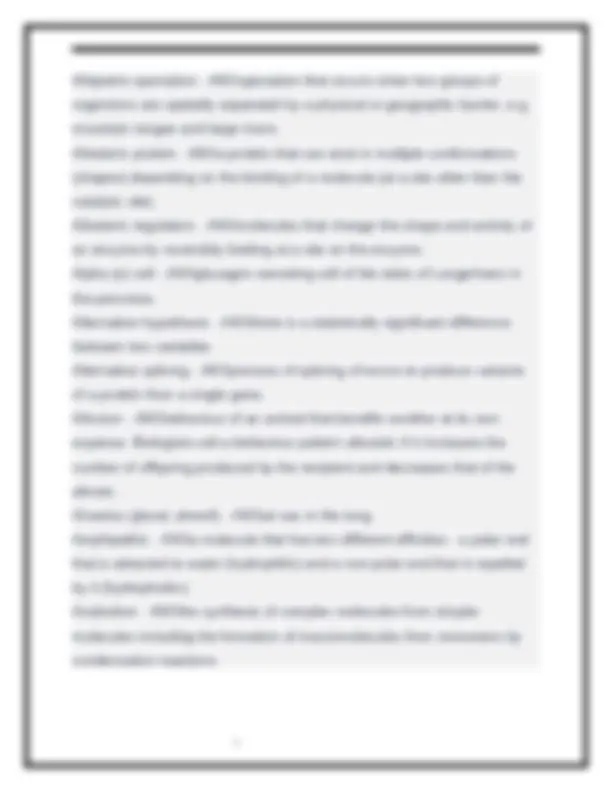
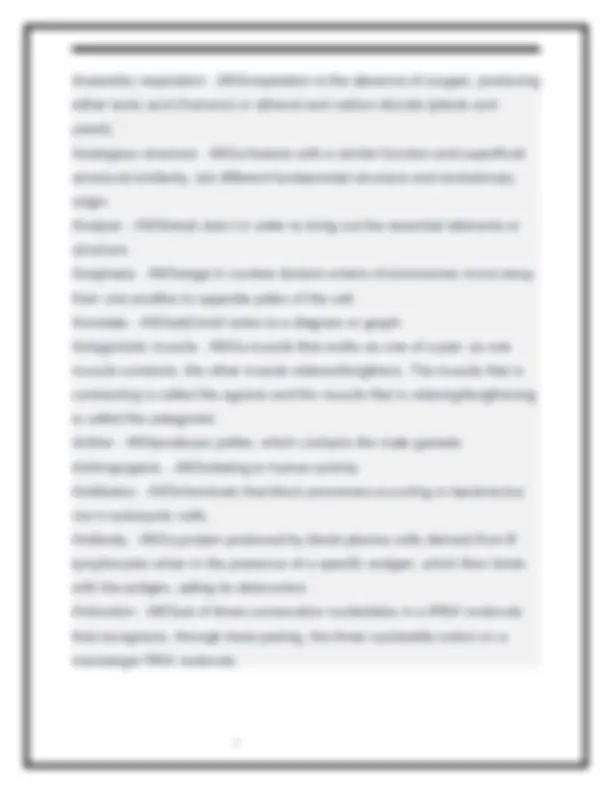
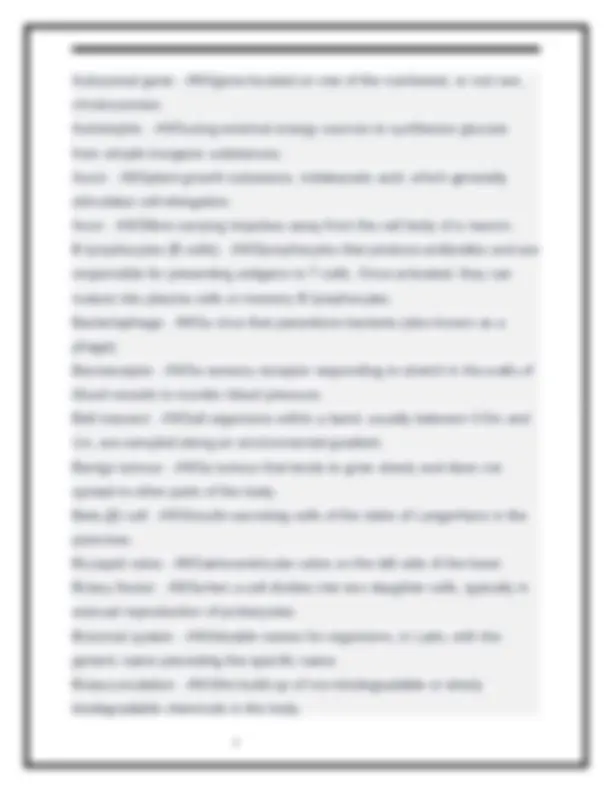
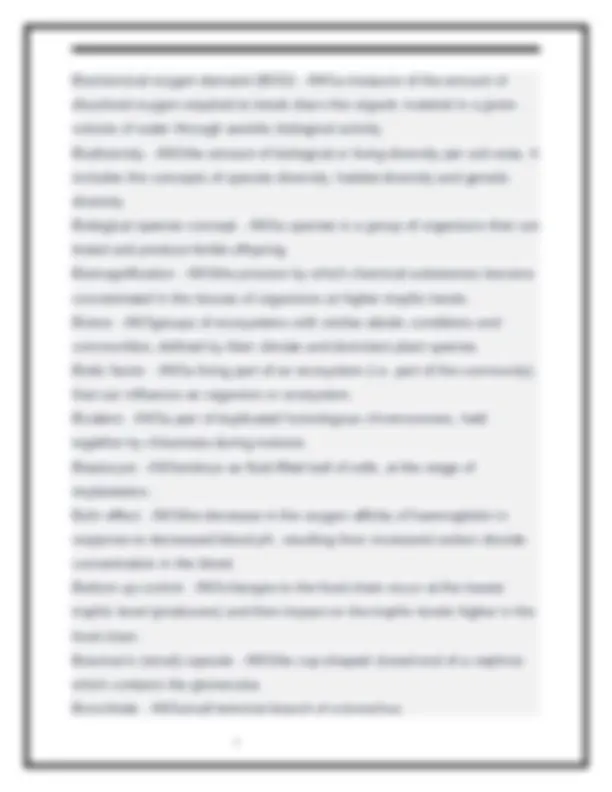
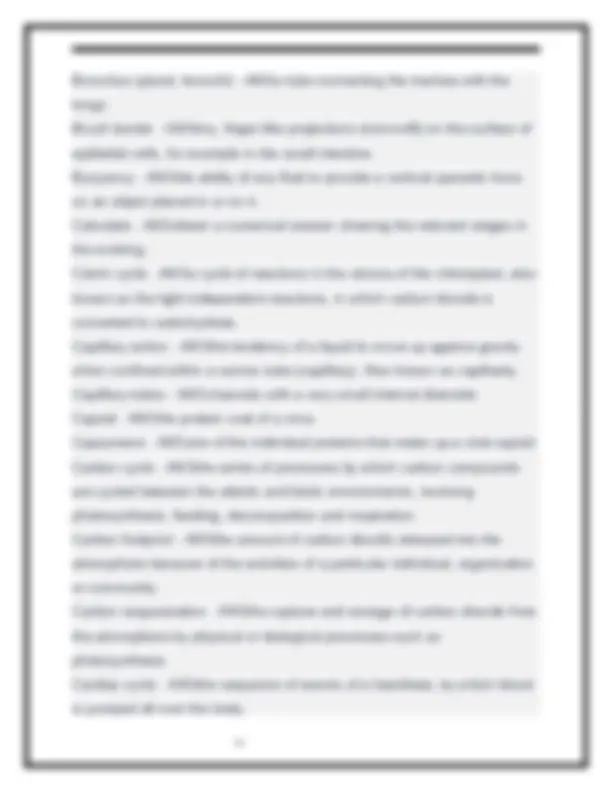
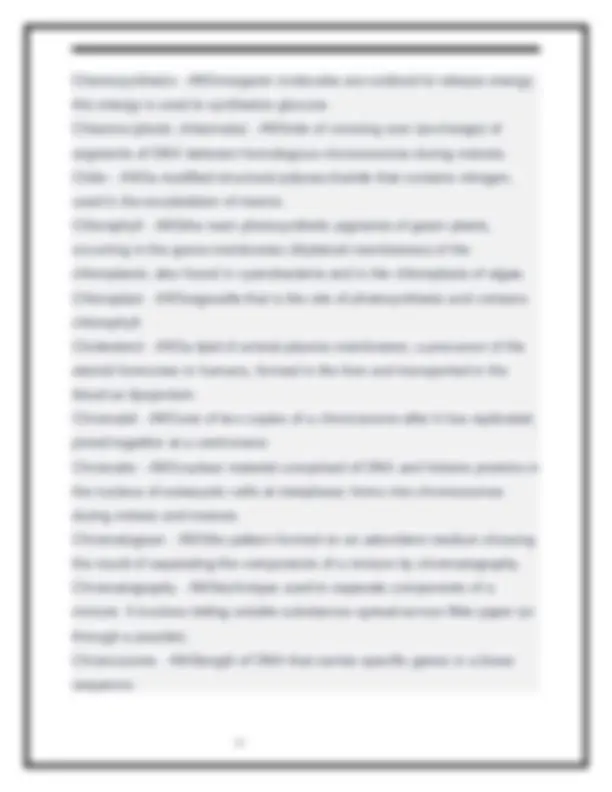
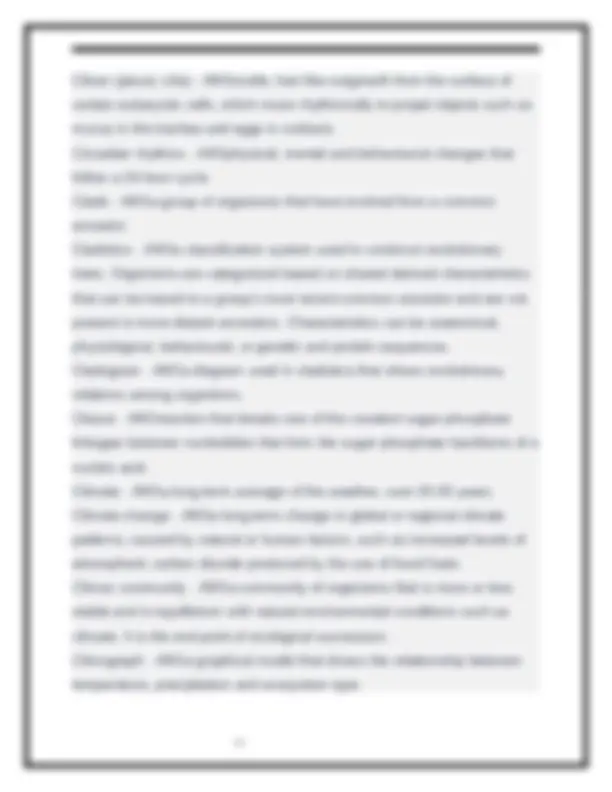
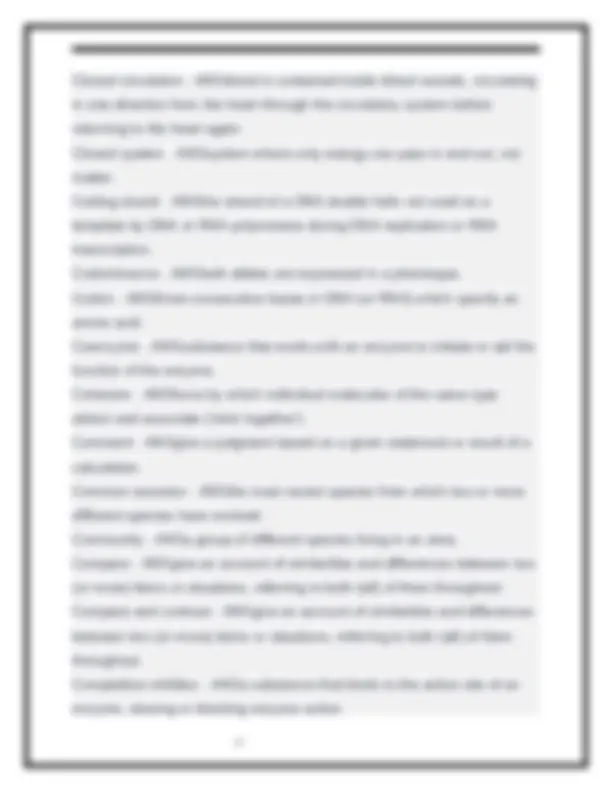
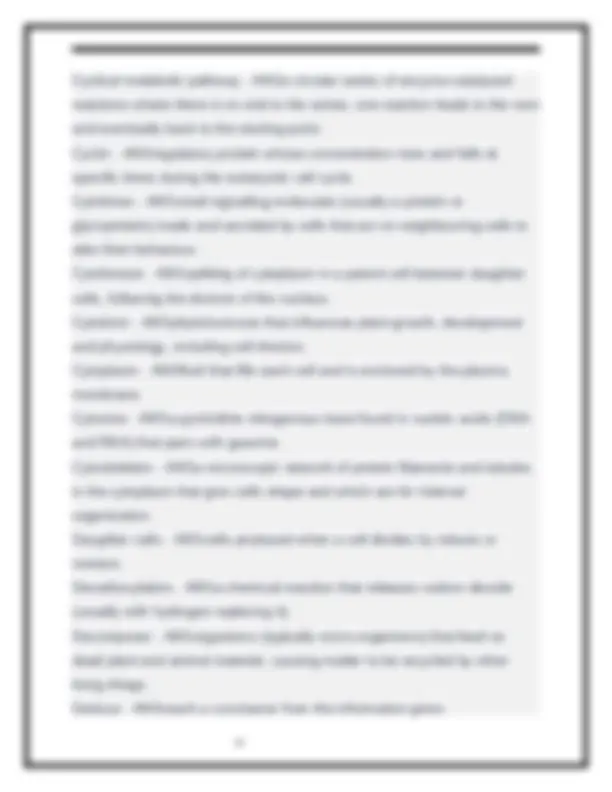
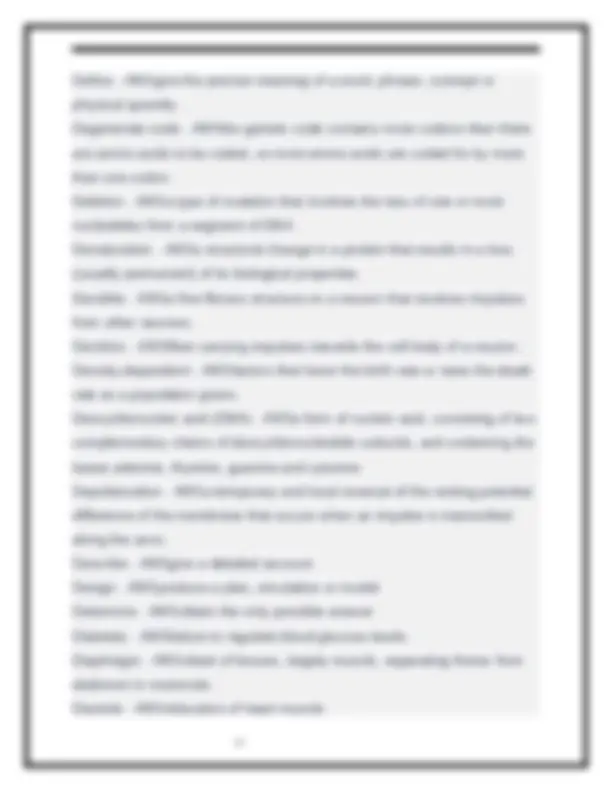
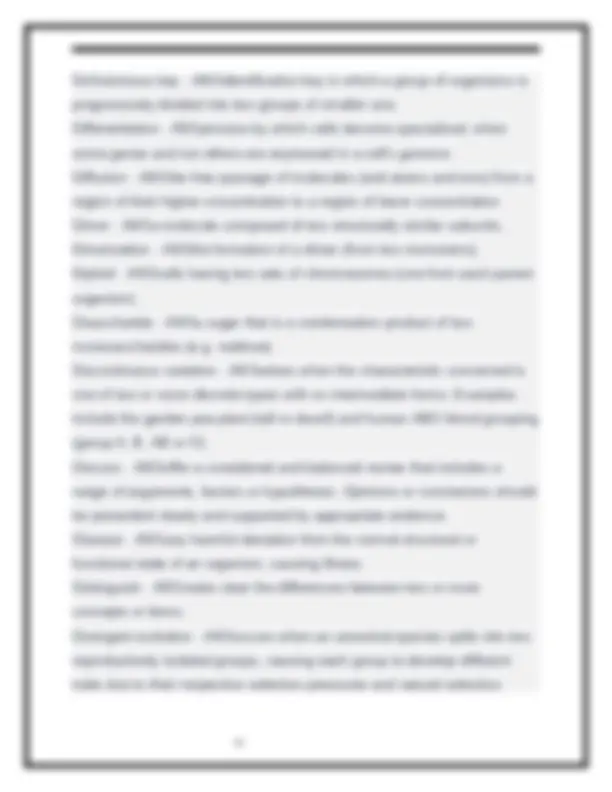
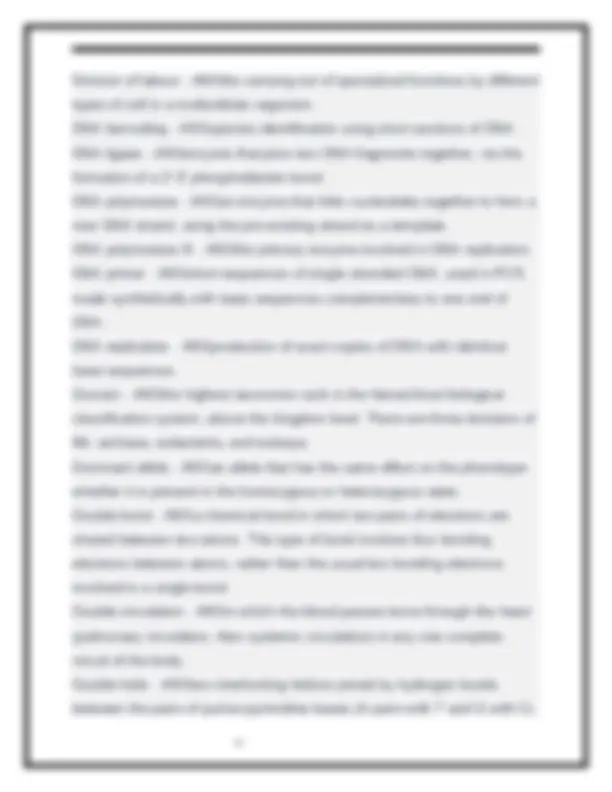
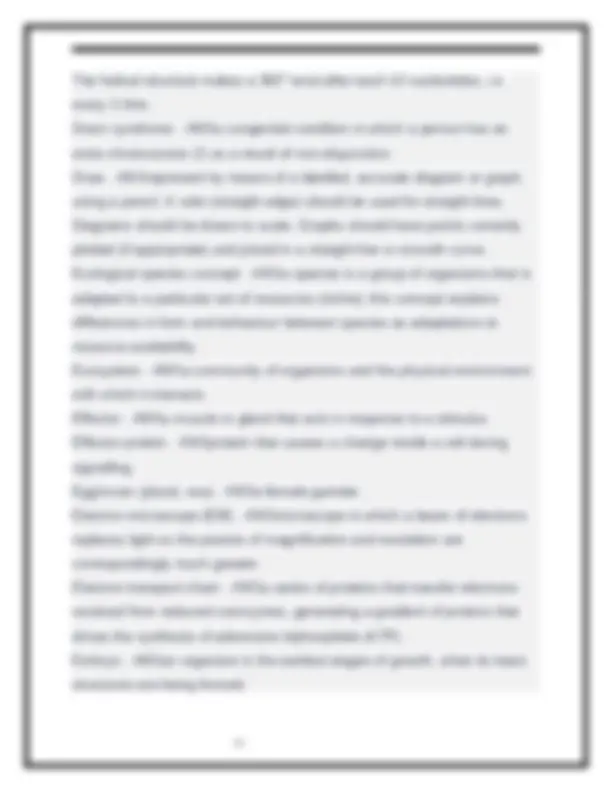
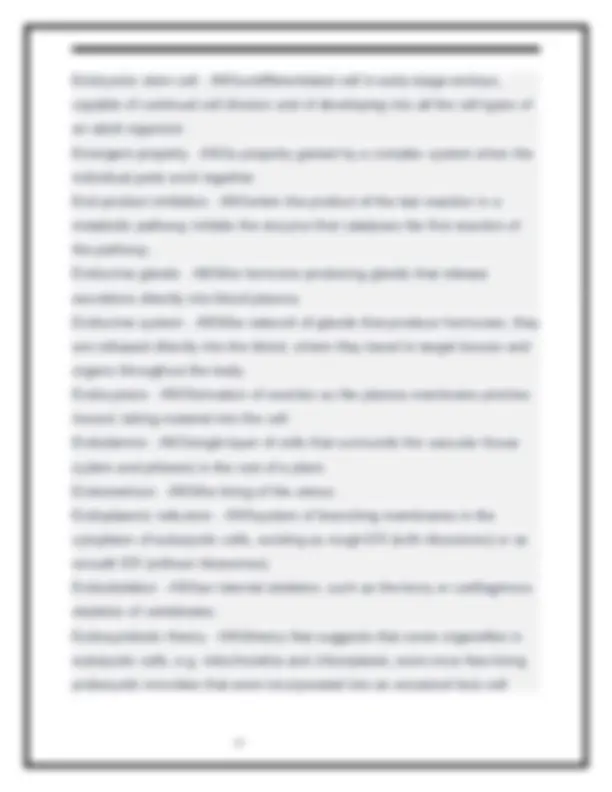
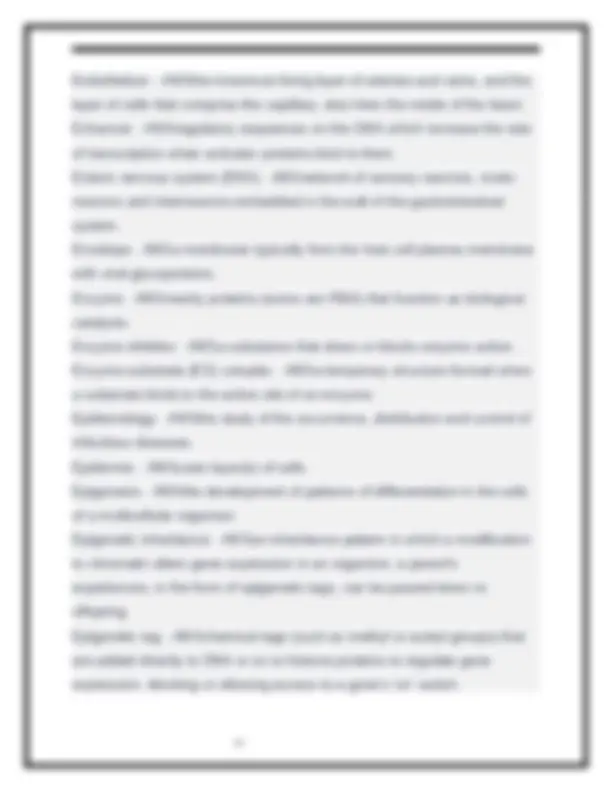
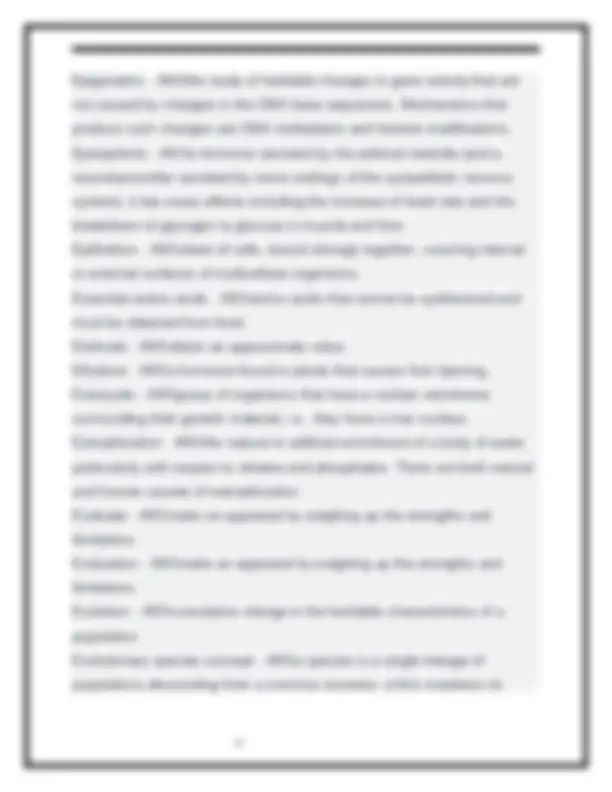
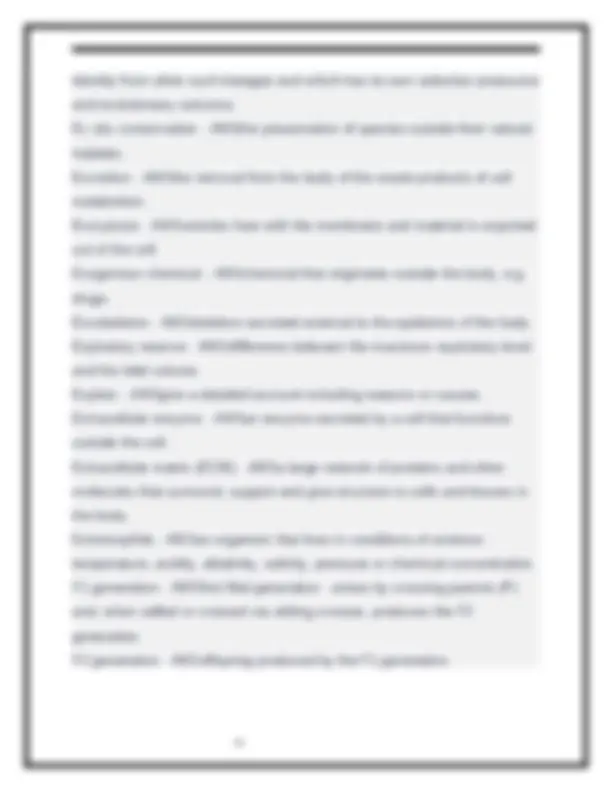
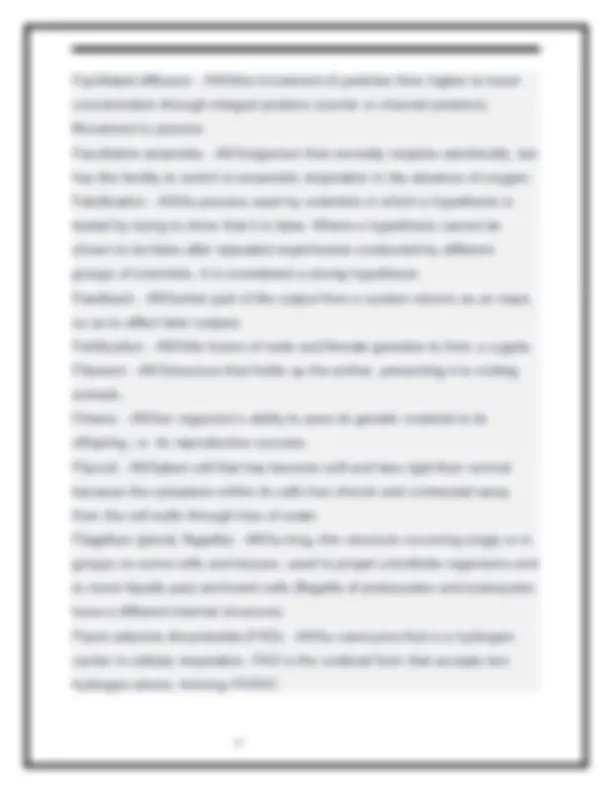
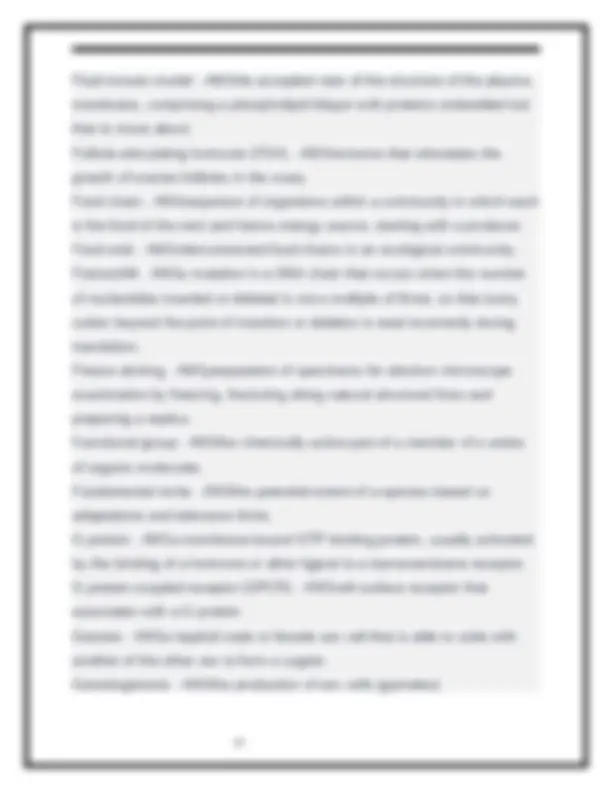
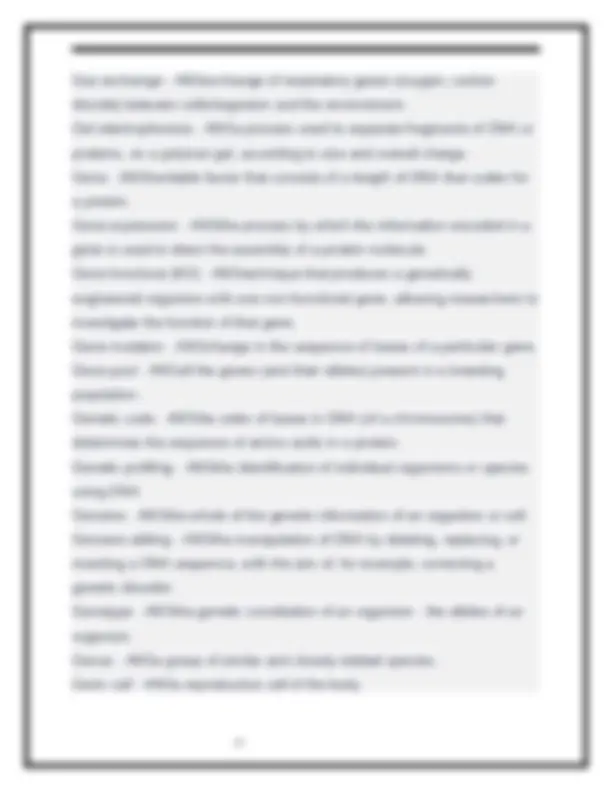
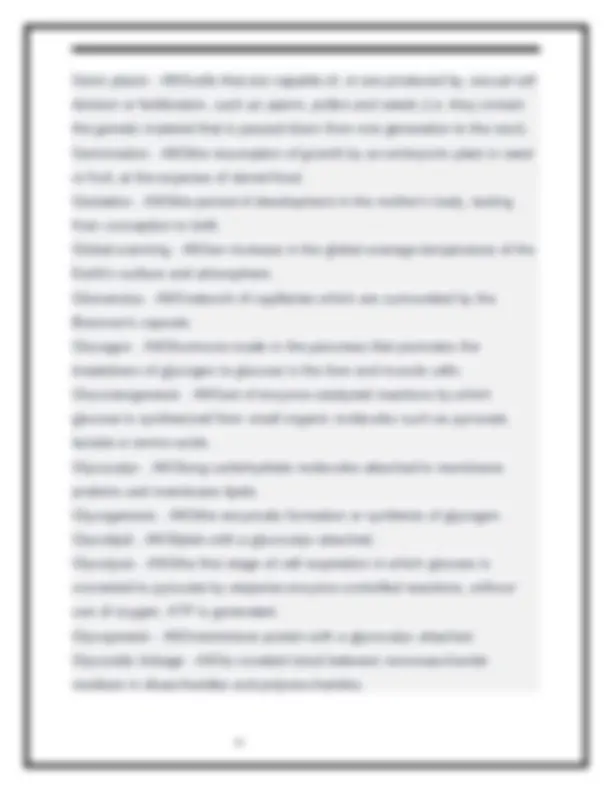
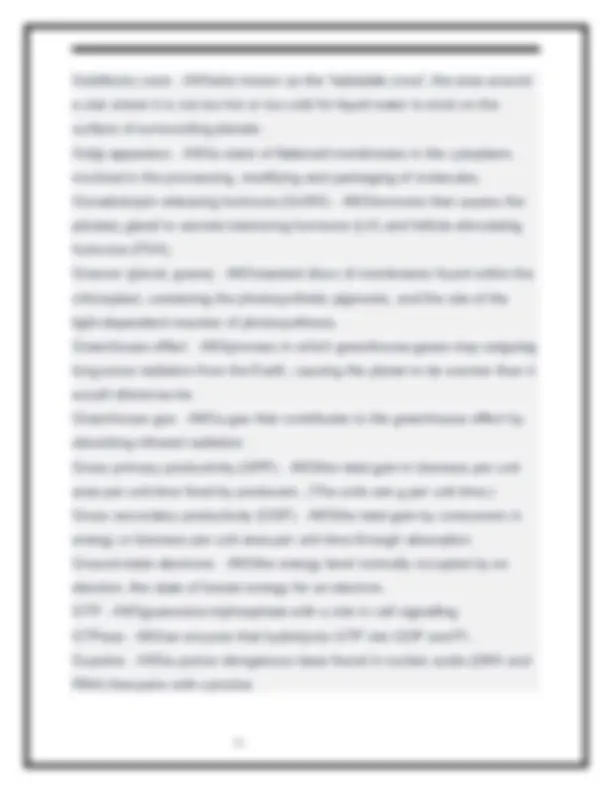
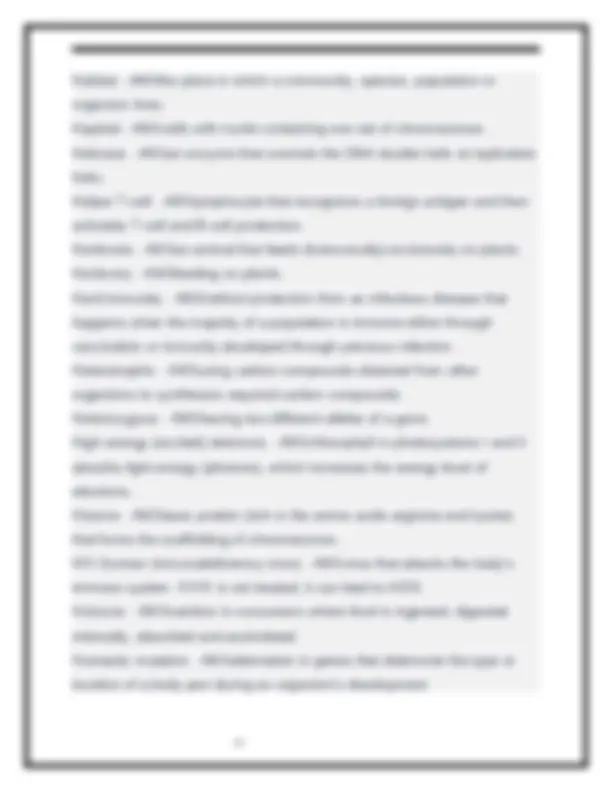
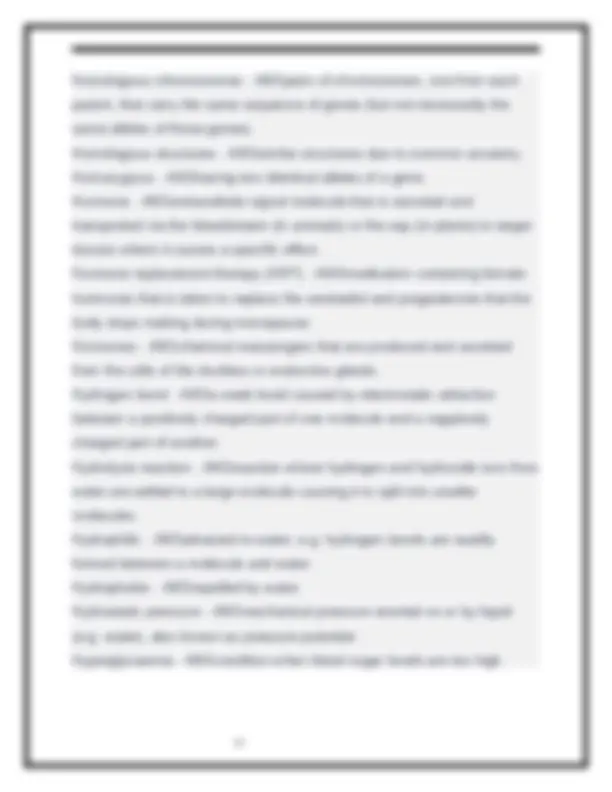
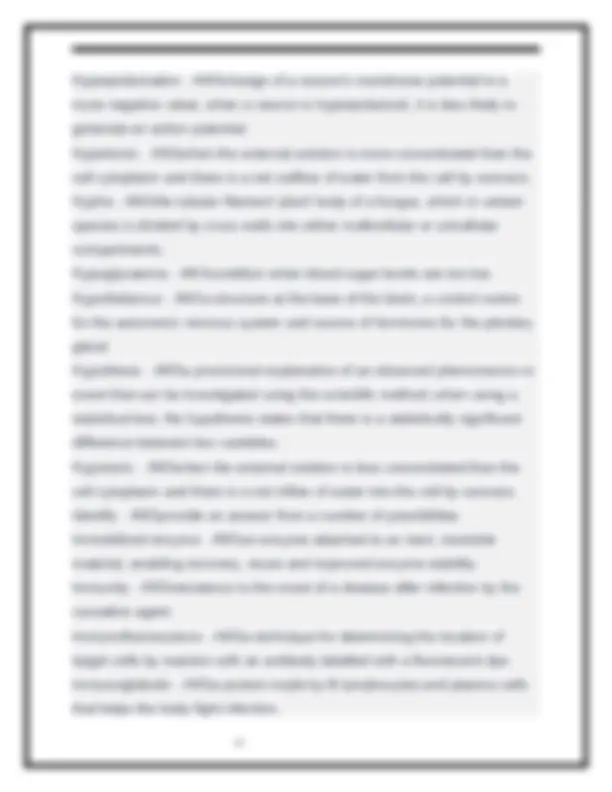
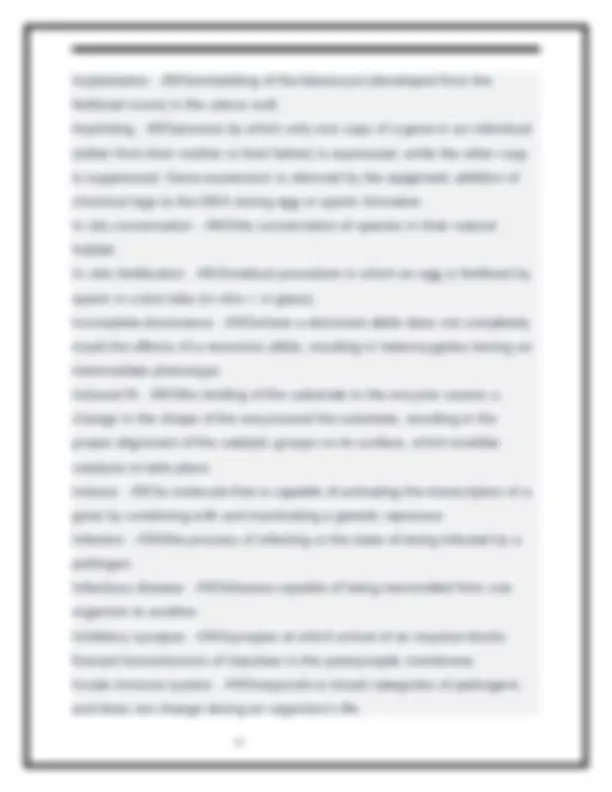
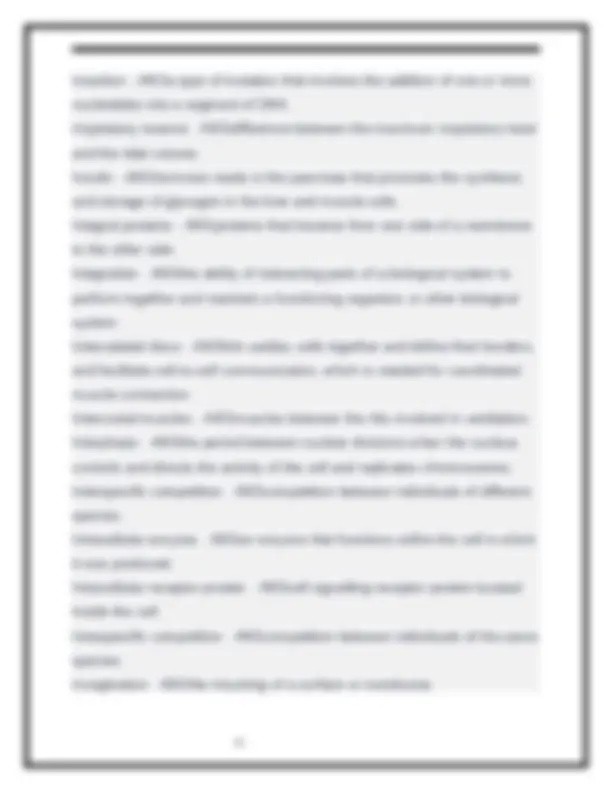
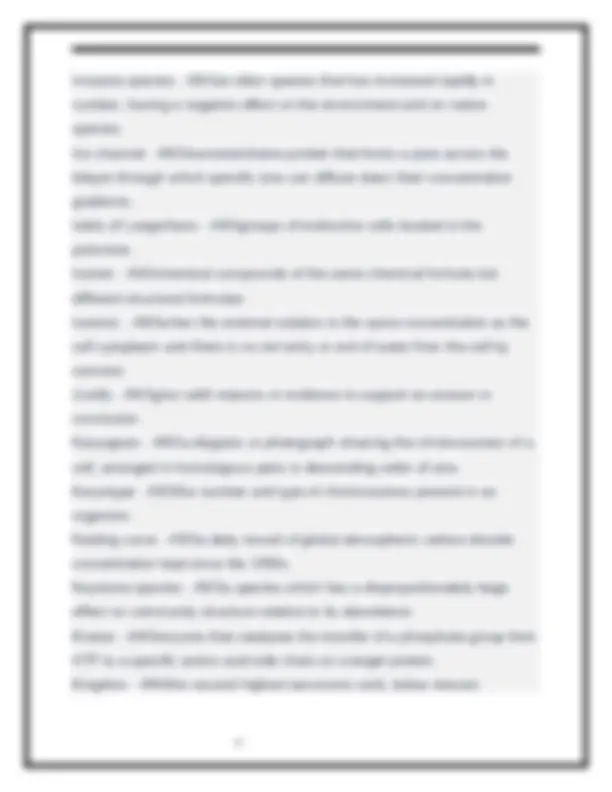
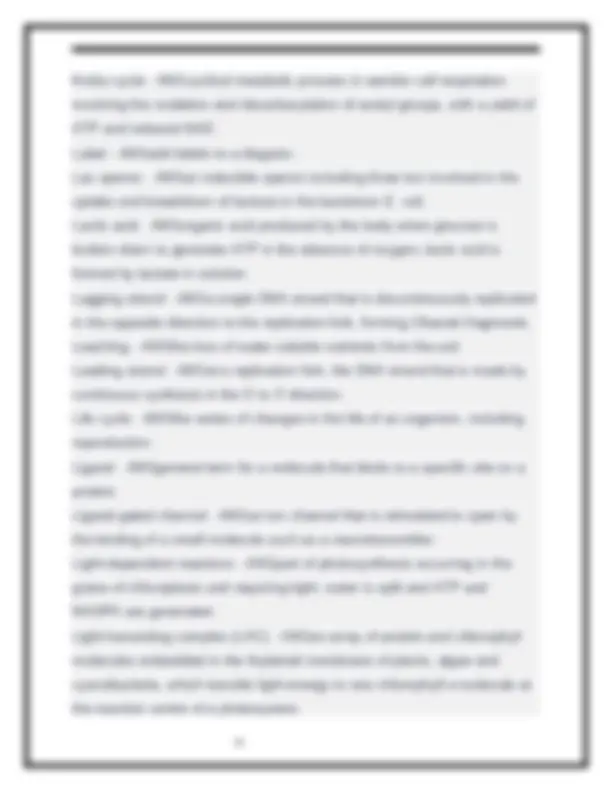
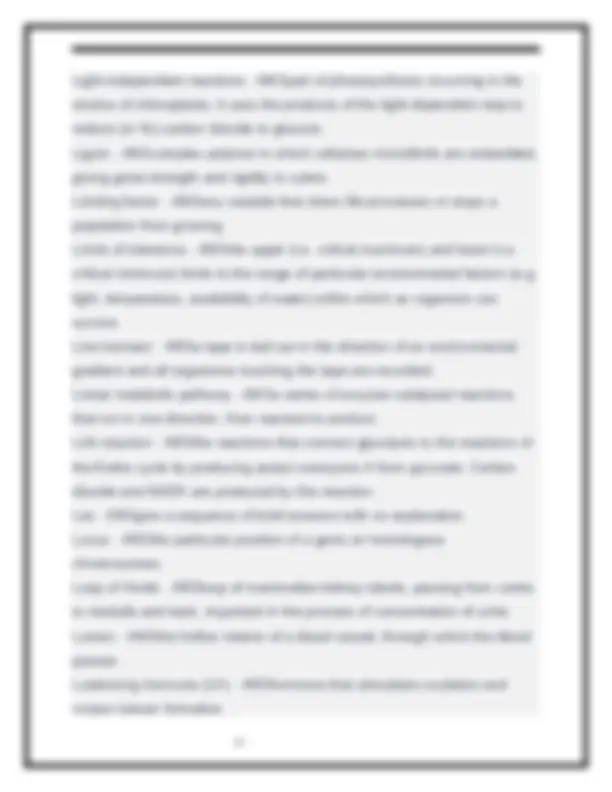
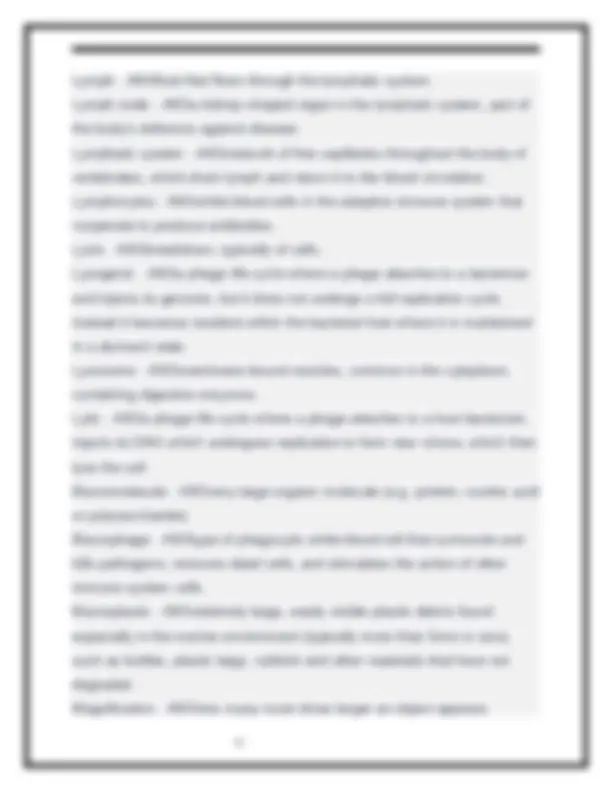
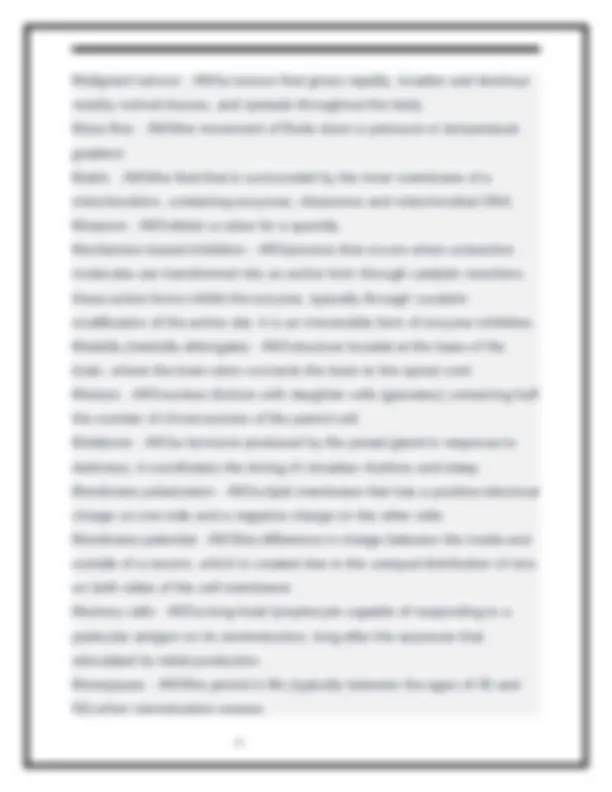
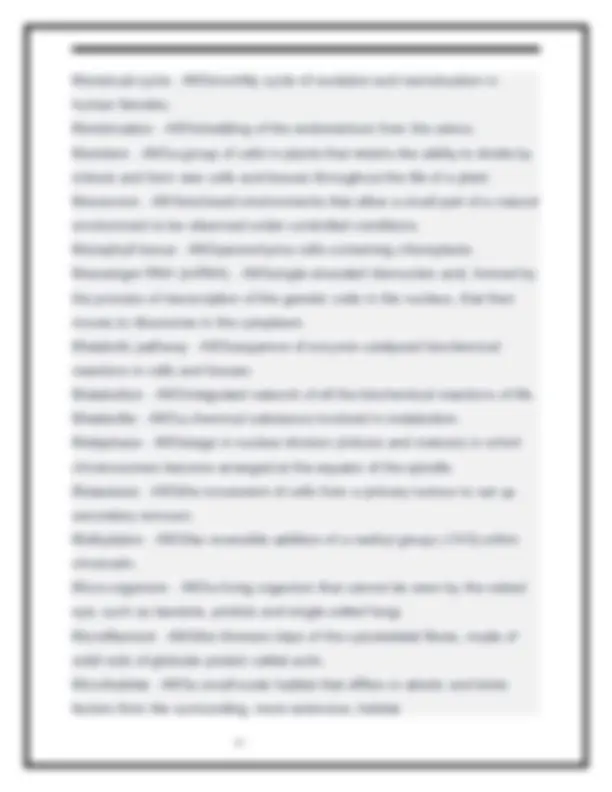
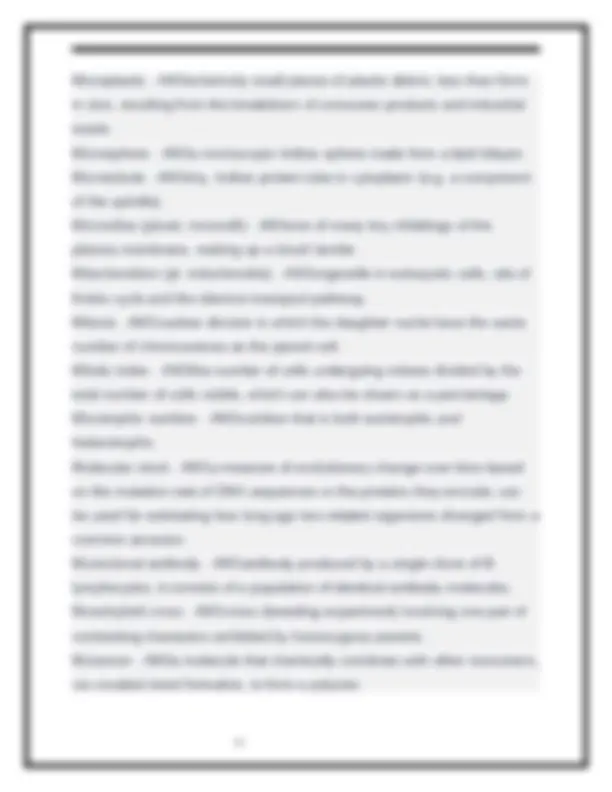
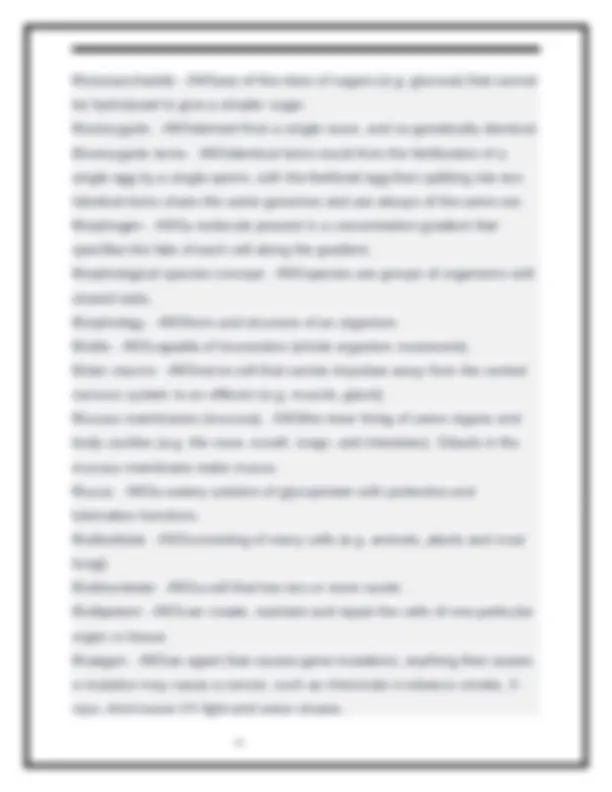
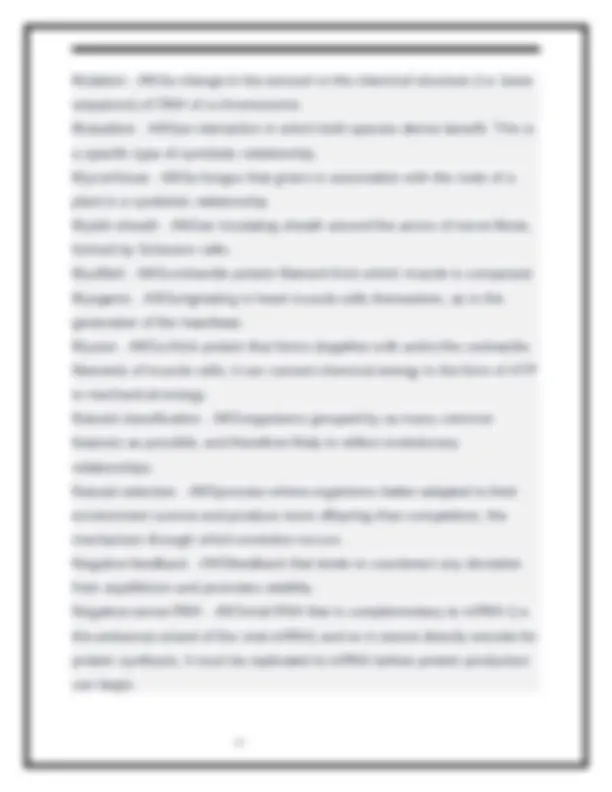
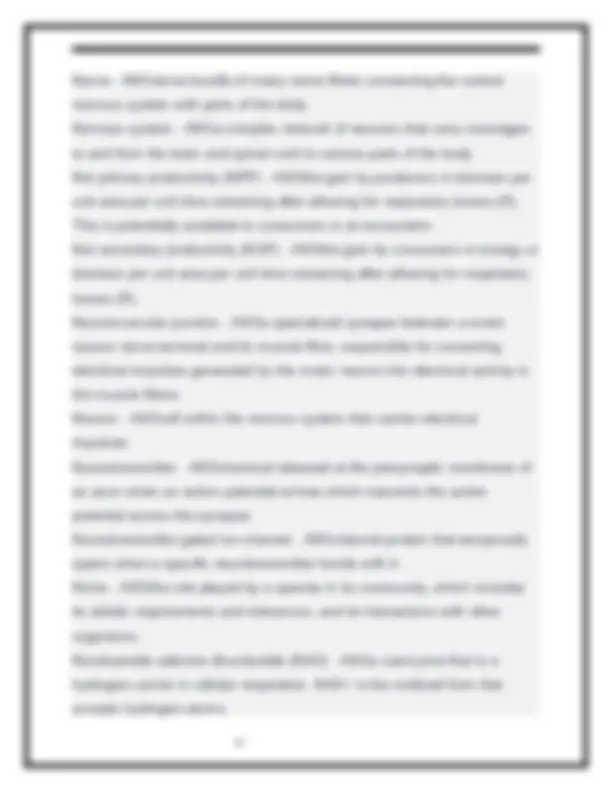
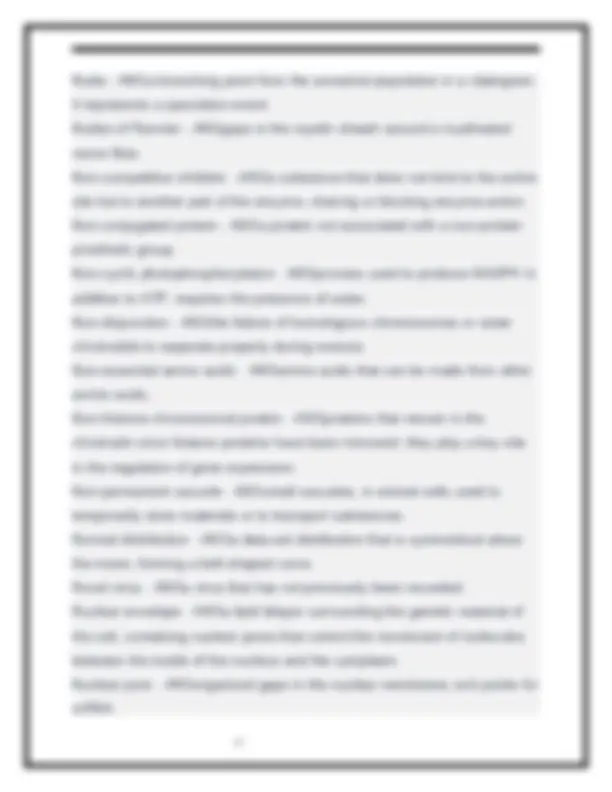
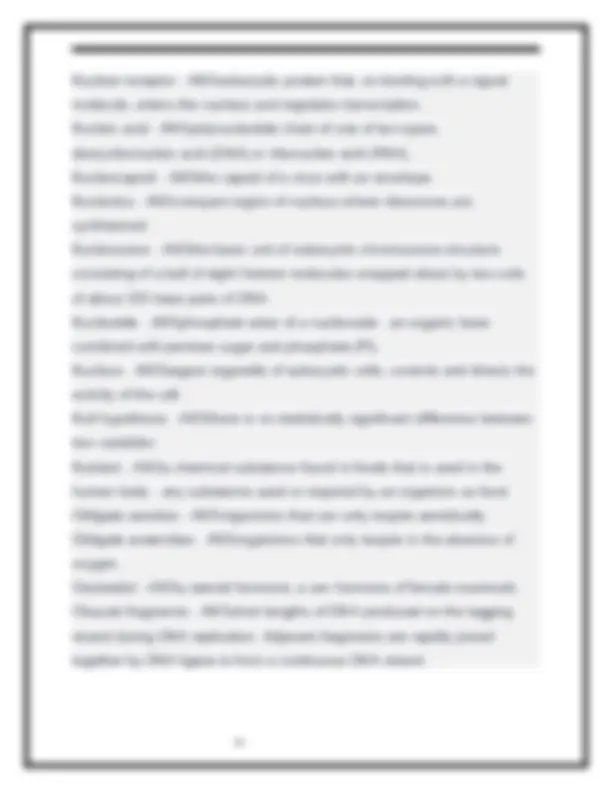
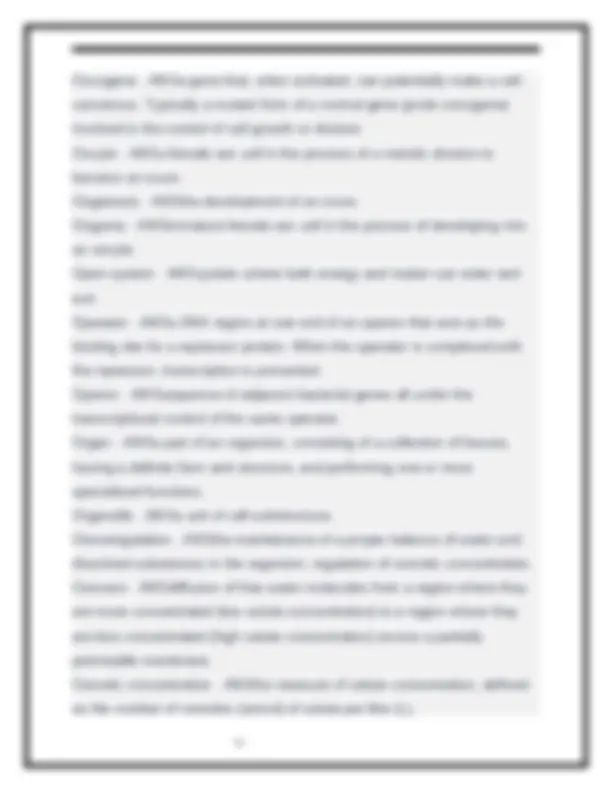
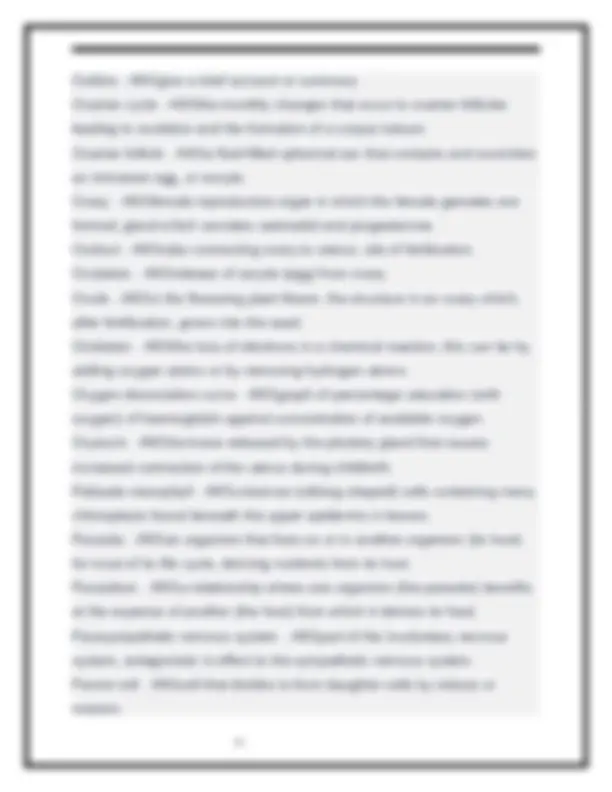
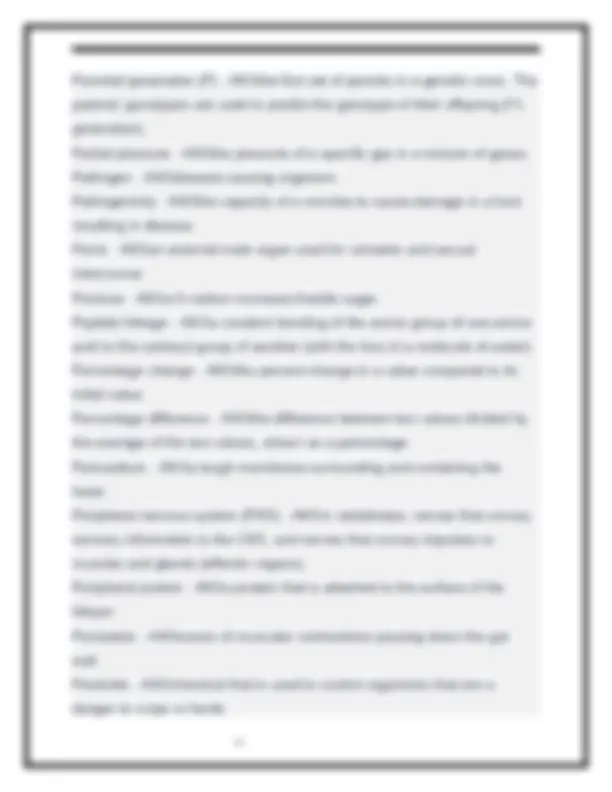
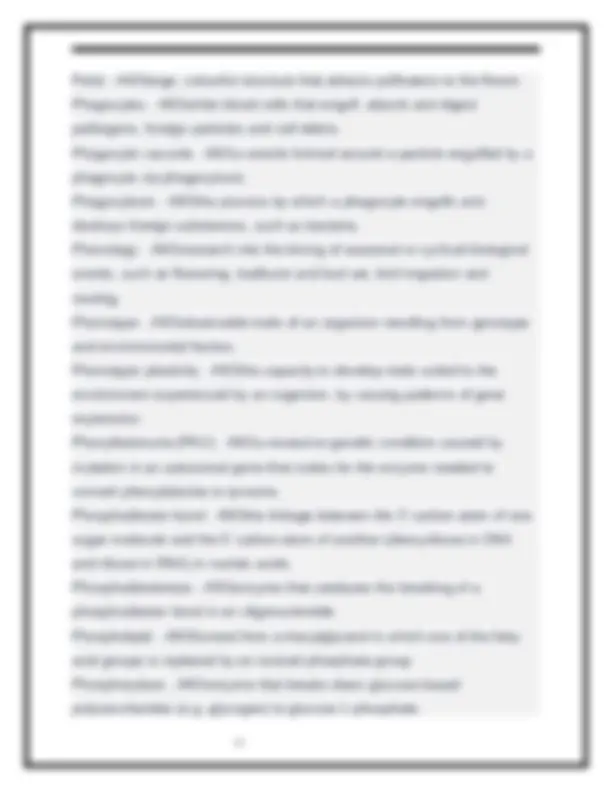

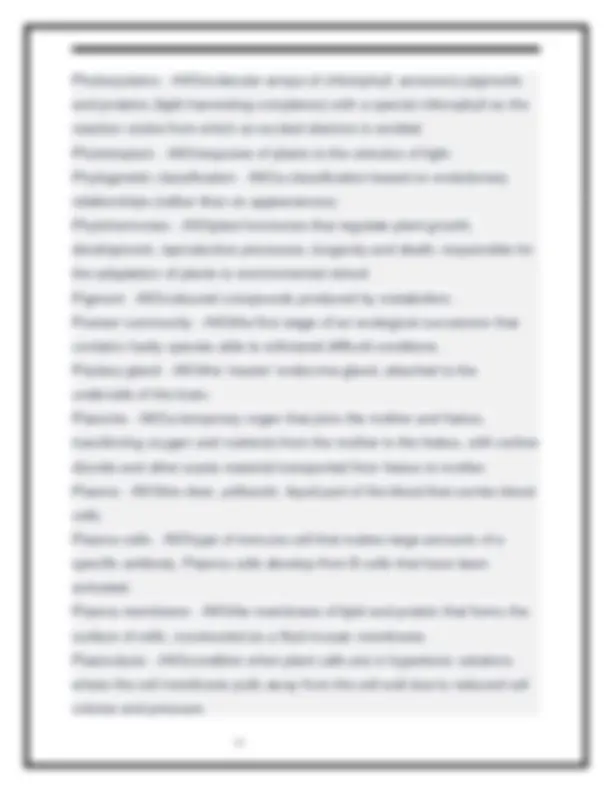
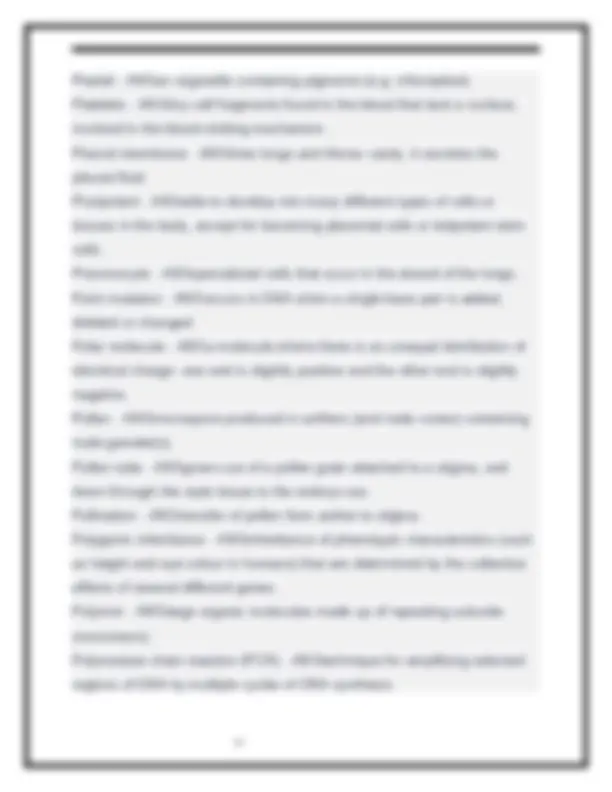
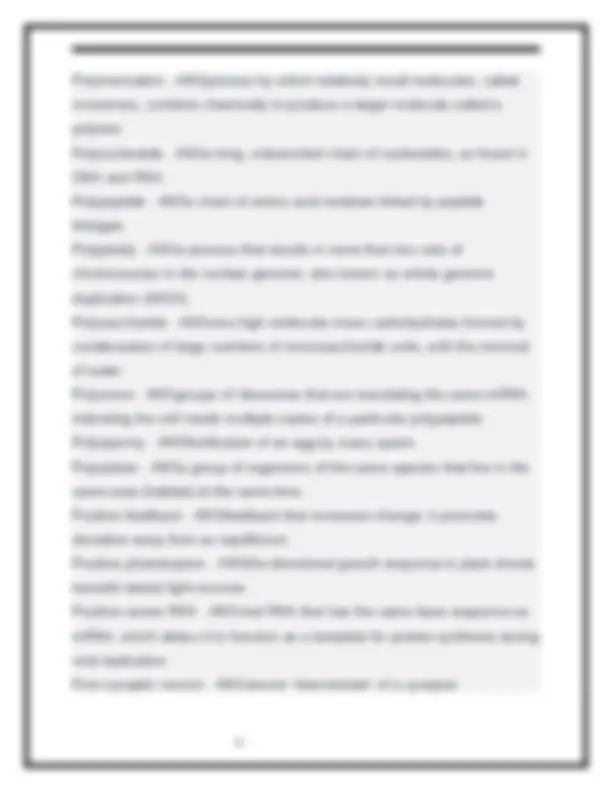
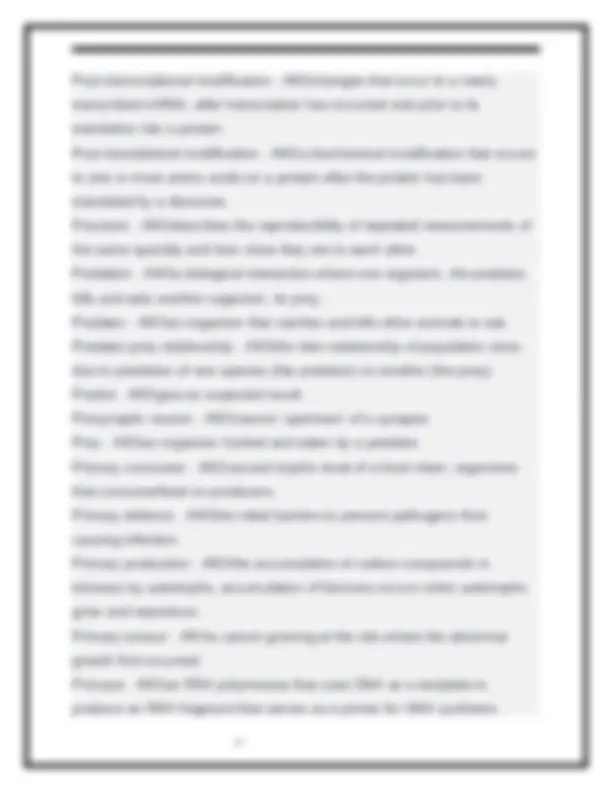
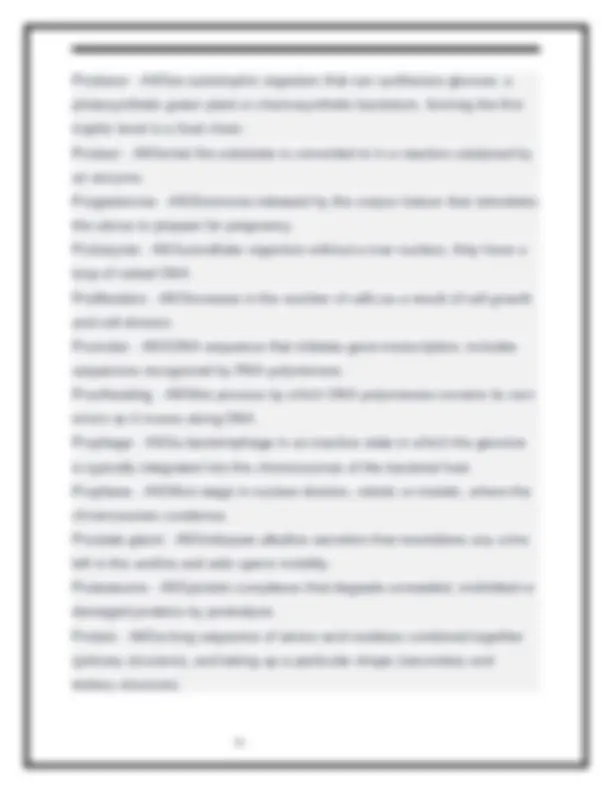
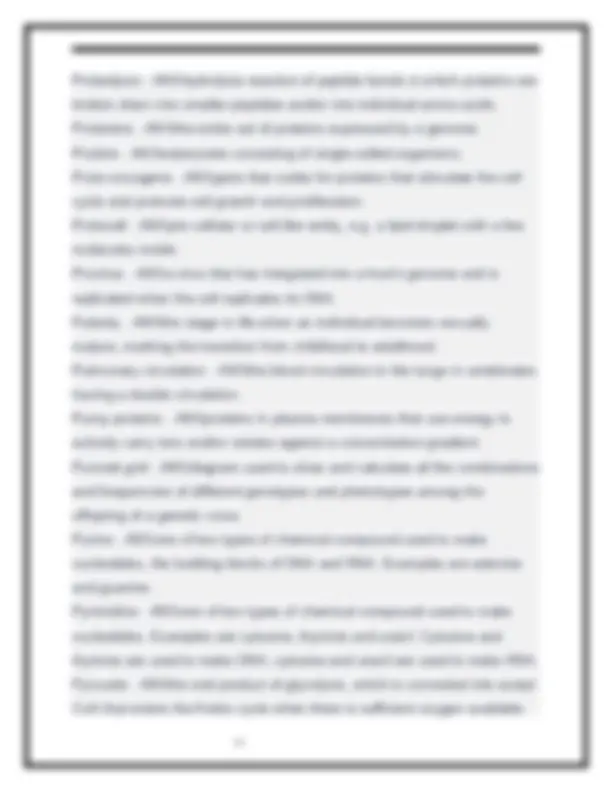
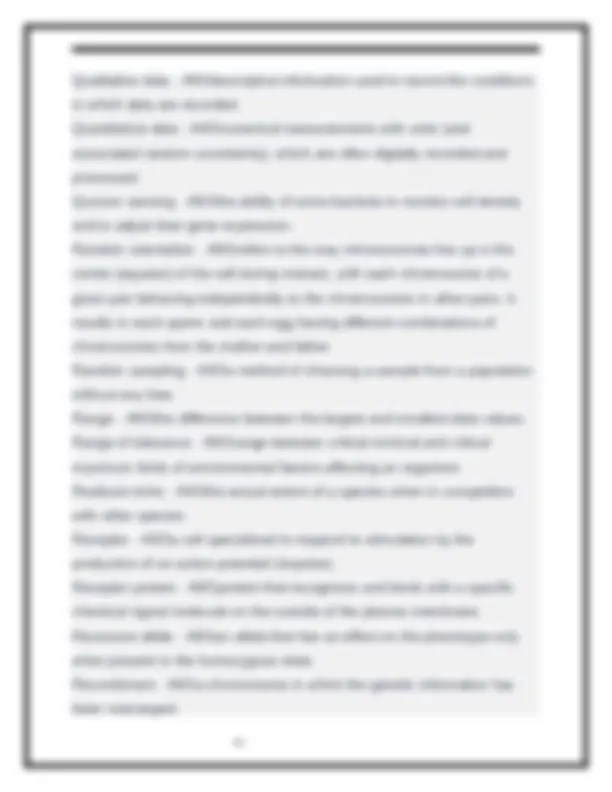
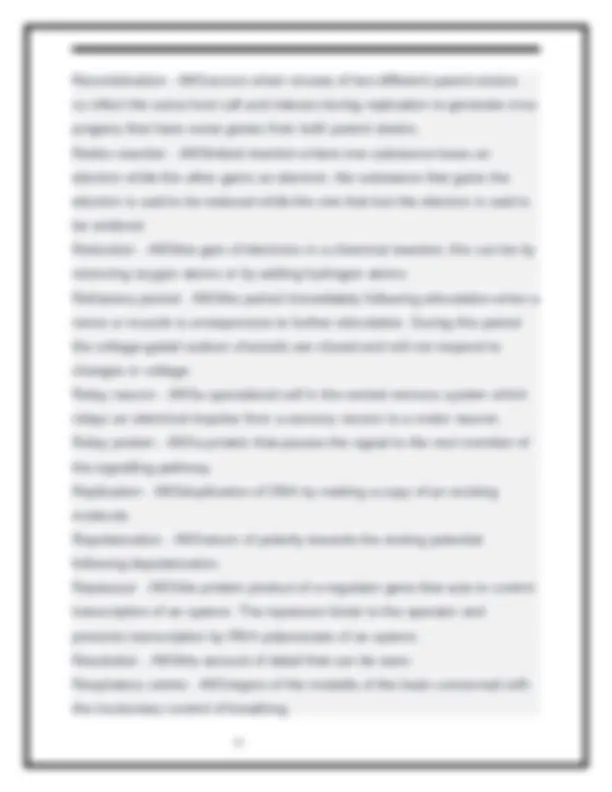
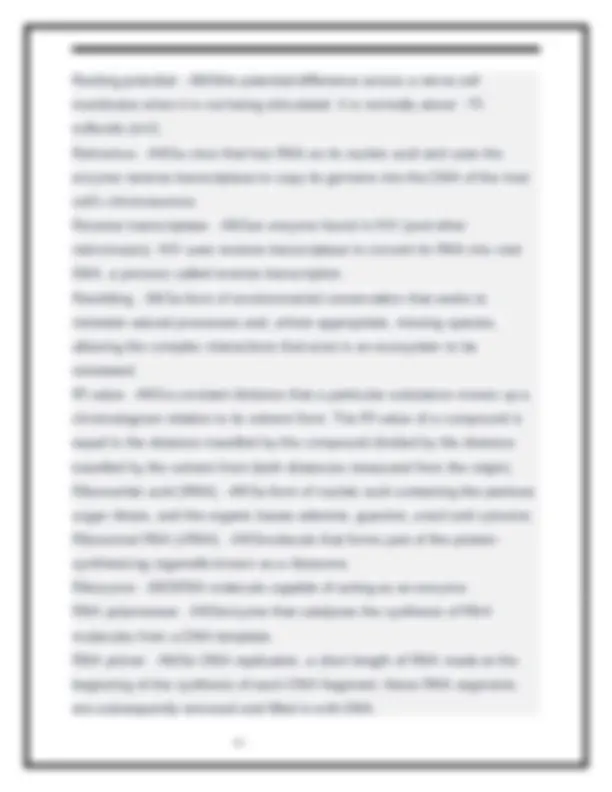
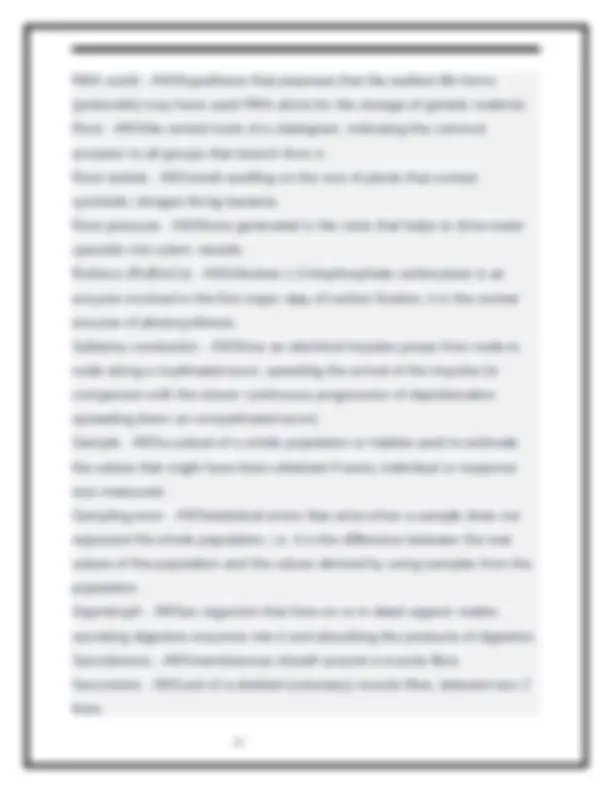
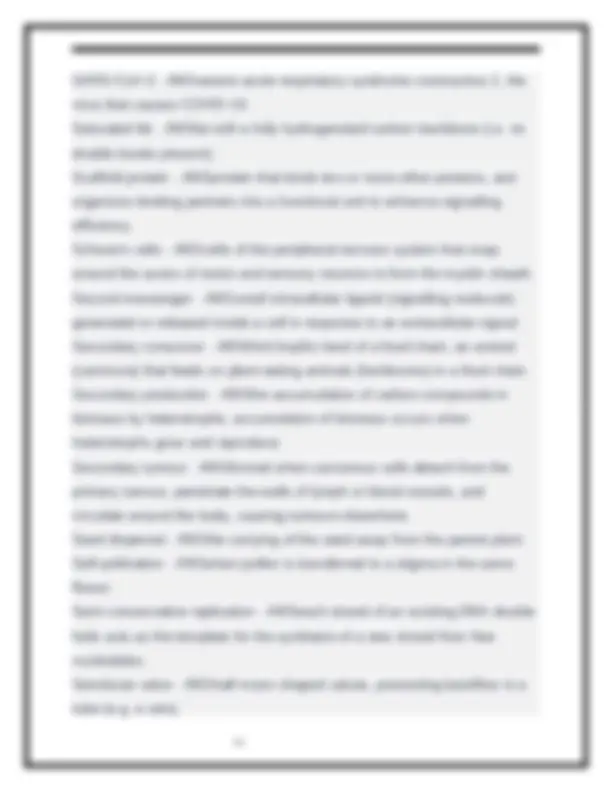
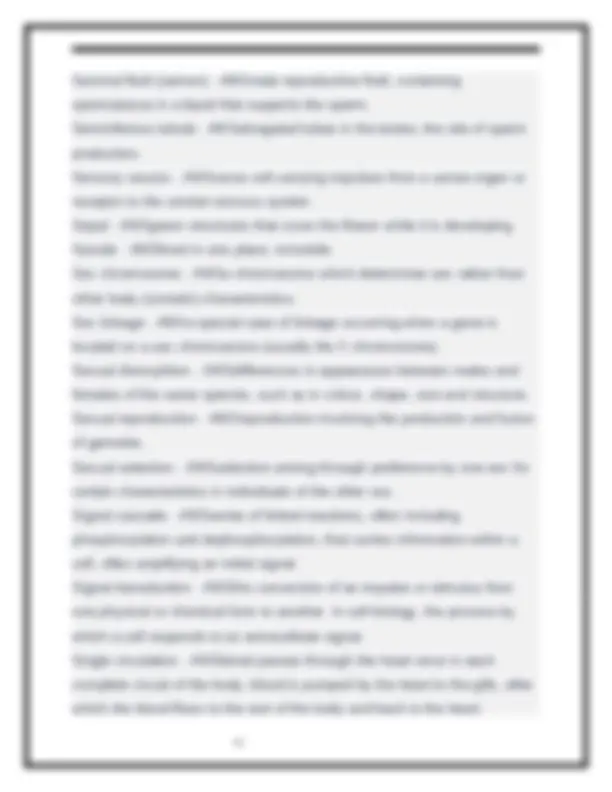
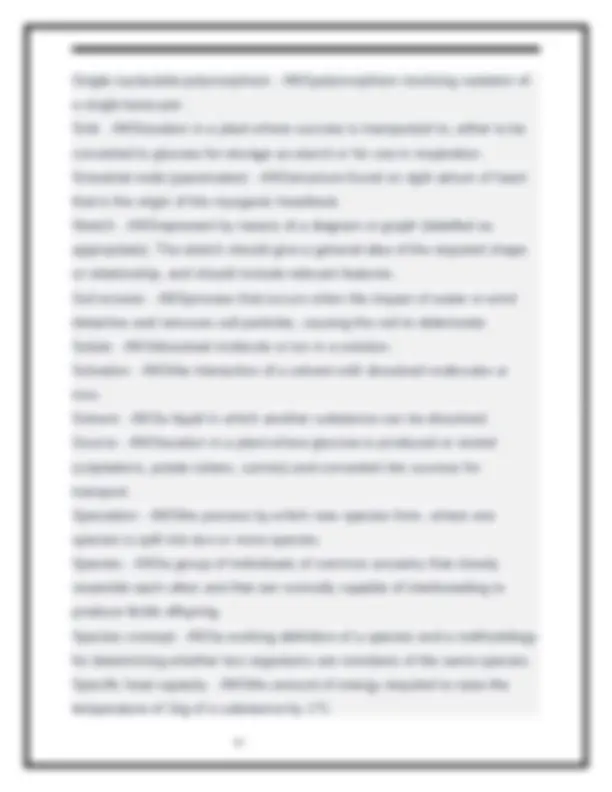
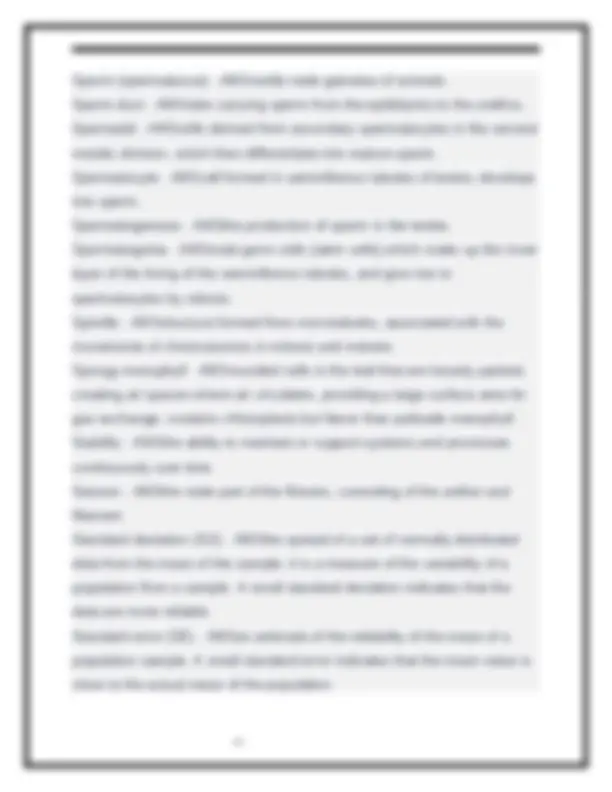
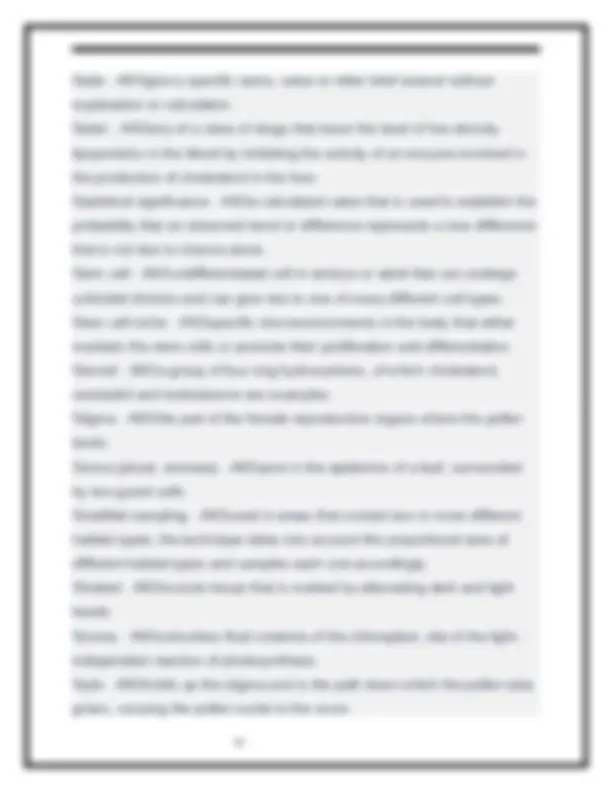
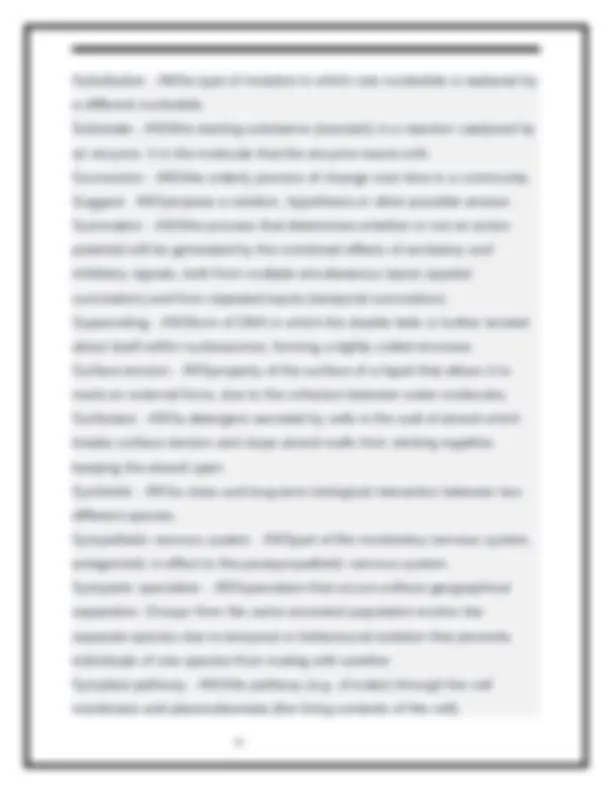
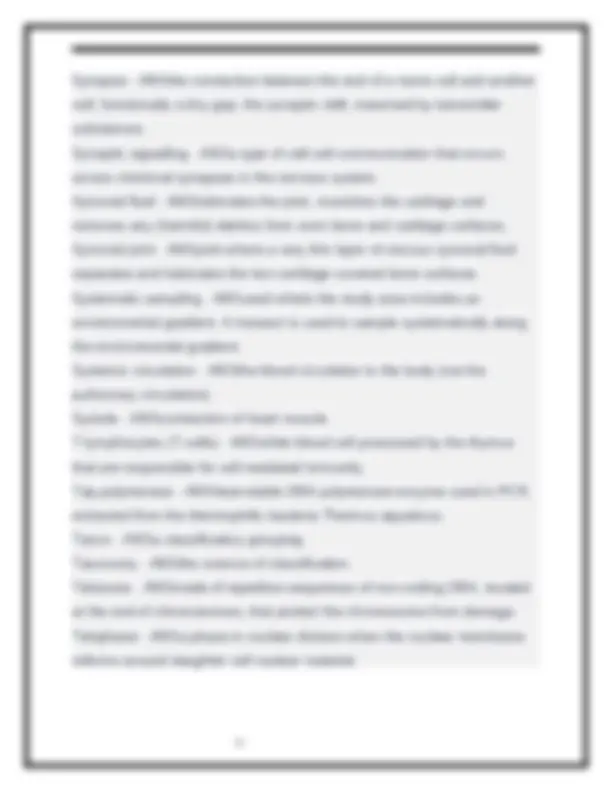
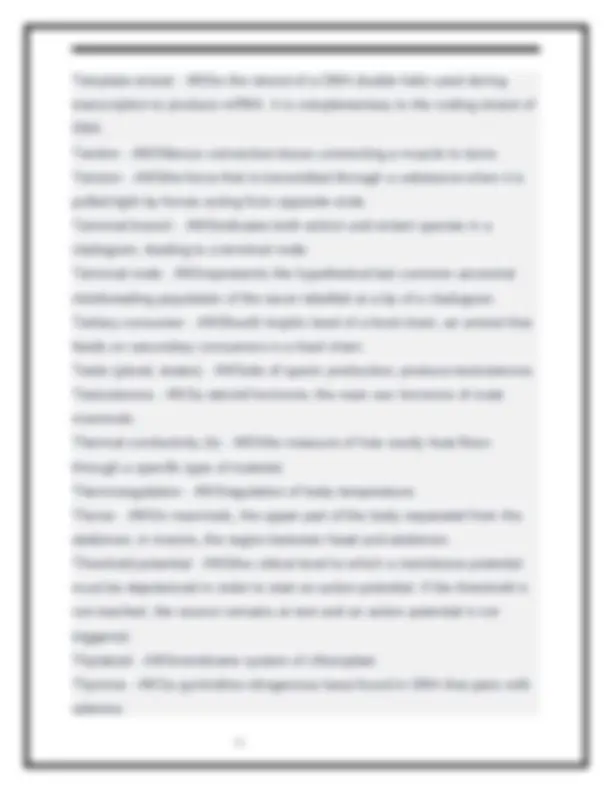
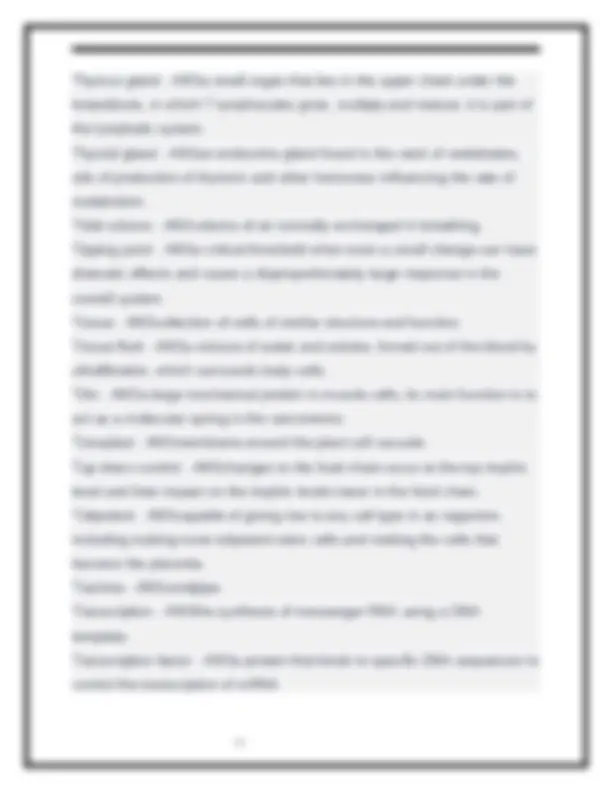
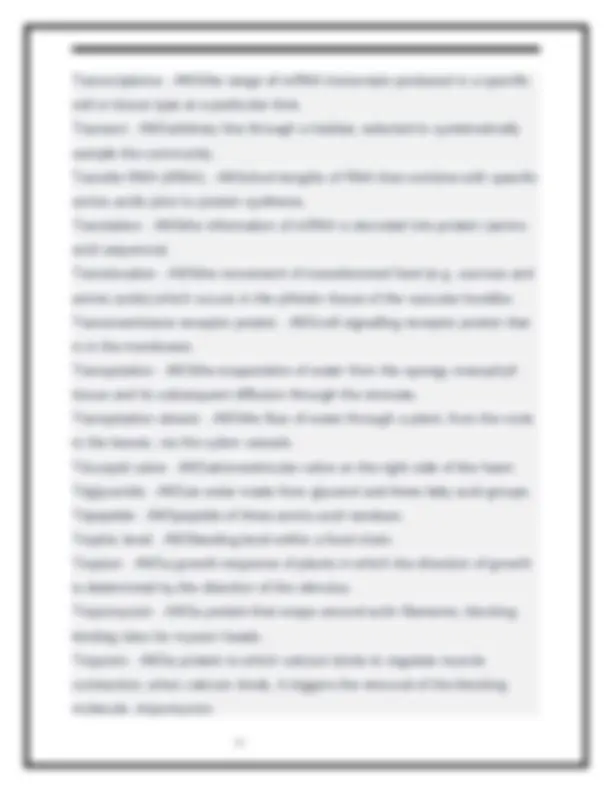
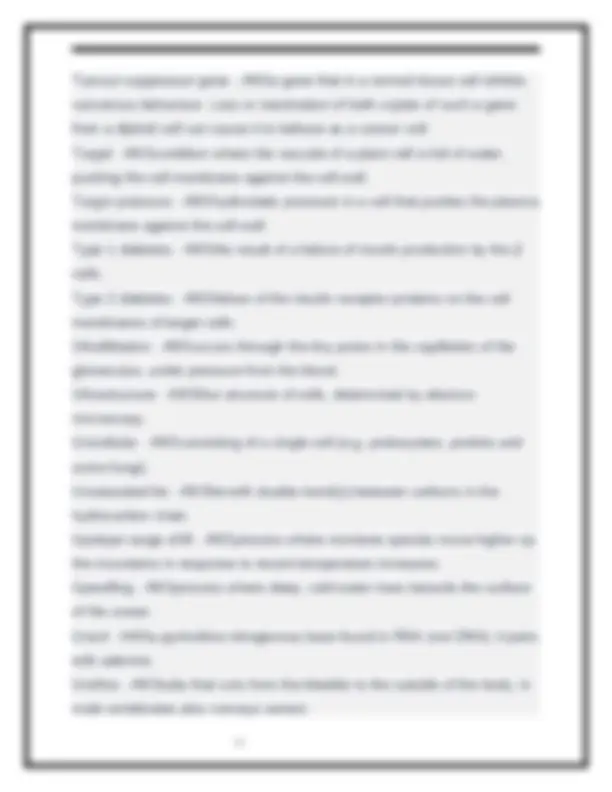
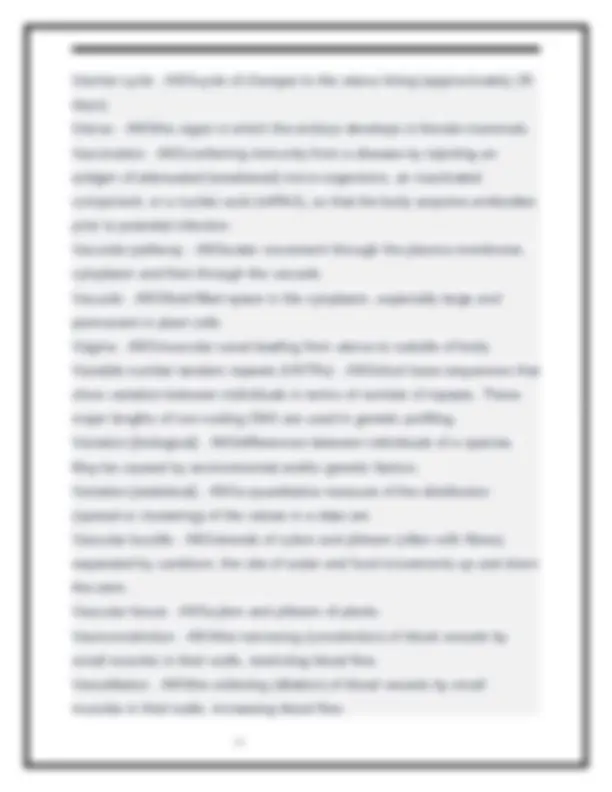
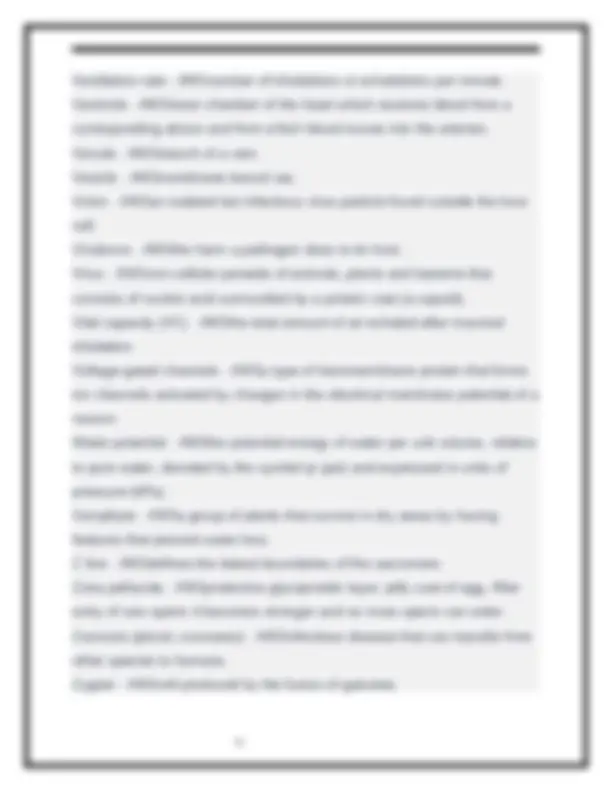


Study with the several resources on Docsity

Earn points by helping other students or get them with a premium plan


Prepare for your exams
Study with the several resources on Docsity

Earn points to download
Earn points by helping other students or get them with a premium plan
Community
Ask the community for help and clear up your study doubts
Discover the best universities in your country according to Docsity users
Free resources
Download our free guides on studying techniques, anxiety management strategies, and thesis advice from Docsity tutors
IB Diploma Biology (First Assessment 2025-2026 Edition) Questions & Correct Answers. Graded A
Typology: Exams
1 / 76

This page cannot be seen from the preview
Don't miss anything!





































































Abiotic - ANS the non-living components of an ecosystem. Abiotic factor - ANS a non-living, physical factor that can influence an organism or ecosystem, e.g. temperature, sunlight, pH, salinity or precipitation. ABO system - ANSa system of four basic blood types (A, AB, B and O), based on the presence or absence of specific inherited antigens. Absorption spectrum - ANSa graph showing the relative absorbance of different wavelengths of light by a pigment. Accessory pigments - ANSlight-absorbing compounds that trap light energy and channel it to chlorophyll a, the primary pigment, which initiates the reactions of photosynthesis. Accuracy - ANShow close to the true value a result is. Acetylcholine (ACh) - ANSa neurotransmitter that functions in both the central and peripheral nervous systems. Acrosome - ANSsac at head of sperm containing protease enzymes. Actin - ANSa thin protein that forms (together with myosin) the contractile filaments of muscle cells; contains binding sites for the myosin heads. Action potential - ANSthe potential difference produced across the plasma membrane of the nerve cell when stimulated, reversing the resting potential from about −70mV to about +40mV. Action spectrum - ANSrange of wavelengths of light within which a process like photosynthesis takes place.
Activated B-cell - ANSB-cells absorb an antigen and present pieces of it on their surface via a major histocompatibility complex (MHC); helper T-cells then recognize the antigens via the MHC and activate the B-cells, resulting in B-cell differentiation into memory B-cells or plasma cells. Activation energy - ANSenergy required by a substrate molecule before it can undergo a chemical change. Active site - ANSregion of an enzyme molecule where the substrate molecule binds and catalysis occurs. Active transport - ANSmovement of particles from lower to higher concentration, using energy from ATP that has been created during respiration. Movement is through carrier proteins. Adaptive immune system - ANSresponds in a specific way to particular pathogens and builds up a memory of pathogens encountered, so the immune response becomes more effective. Adaptive radiation - ANSthe diversification of an ancestral species into new species, characterized by great ecological and morphological diversity, filling different ecological niches. Adenine - ANSa purine nitrogenous base, found in the coenzymes ATP and NADP, and in nucleic acids (DNA and RNA), that pairs with thymine. Adenosine diphosphate (ADP) - ANSa nucleotide, present in every living cell, made of adenosine and two phosphate groups bonded in a linear sequence; it is important in energy-transfer reactions of metabolism. Adenosine triphosphate (ATP) - ANSa nucleotide, present in every living cell, formed in photosynthesis and respiration from ADP and Pi; it functions in metabolism as a common intermediate between energy-requiring and energy-yielding reactions.
Allopatric speciation - ANSspeciation that occurs when two groups of organisms are spatially separated by a physical or geographic barrier, e.g. mountain ranges and large rivers. Allosteric protein - ANSa protein that can exist in multiple conformations (shapes) depending on the binding of a molecule (at a site other than the catalytic site). Allosteric regulators - ANSmolecules that change the shape and activity of an enzyme by reversibly binding at a site on the enzyme. Alpha (α) cell - ANSglucagon-secreting cell of the islets of Langerhans in the pancreas. Alternative hypothesis - ANSthere is a statistically significant difference between two variables. Alternative splicing - ANSprocess of splicing of exons to produce variants of a protein from a single gene. Altruism - ANSbehaviour of an animal that benefits another at its own expense. Biologists call a behaviour pattern altruistic if it increases the number of offspring produced by the recipient and decreases that of the altruist. Alveolus (plural, alveoli) - ANSair sac in the lung. Amphipathic - ANSa molecule that has two different affinities - a polar end that is attracted to water (hydrophilic) and a non-polar end that is repelled by it (hydrophobic). Anabolism - ANSthe synthesis of complex molecules from simpler molecules including the formation of macromolecules from monomers by condensation reactions.
Anaerobic respiration - ANSrespiration in the absence of oxygen, producing either lactic acid (humans) or ethanol and carbon dioxide (plants and yeast). Analogous structure - ANSa feature with a similar function and superficial structural similarity, but different fundamental structure and evolutionary origin. Analyse - ANSbreak down in order to bring out the essential elements or structure. Anaphase - ANSstage in nuclear division where chromosomes move away from one another to opposite poles of the cell. Annotate - ANSadd brief notes to a diagram or graph. Antagonistic muscle - ANSa muscle that works as one of a pair: as one muscle contracts, the other muscle relaxes/lengthens. The muscle that is contracting is called the agonist and the muscle that is relaxing/lengthening is called the antagonist. Anther - ANSproduces pollen, which contains the male gamete. Anthropogenic - ANSrelating to human activity. Antibiotics - ANSchemicals that block processes occurring in bacteria but not in eukaryotic cells. Antibody - ANSa protein produced by blood plasma cells derived from B lymphocytes when in the presence of a specific antigen, which then binds with the antigen, aiding its destruction. Anticodon - ANSset of three consecutive nucleotides in a tRNA molecule that recognizes, through base pairing, the three-nucleotide codon on a messenger RNA molecule.
Artificial classification - ANSclassifying organisms on the basis of few, self- evident features. Artificial selection - ANSselection in breeding, carried out deliberately by humans to alter populations. Asexual reproduction - ANSreproduction not involving gametes and fertilization. Assimilation - ANSuptake of nutrients into cells and the utilization of this material to provide energy and to synthesize new biological molecules. Atherosclerosis - ANSdeposition of plaque (cholesterol derivative) in the inner wall of blood vessels. ATP synthase (ATPase) - ANSa complex of integral proteins located in the mitochondrial inner membrane where it catalyses the synthesis of ATP from ADP and phosphate, driven by a flow of protons. ATPase - ANSa group of enzymes that catalyze the hydrolysis of a phosphate bond in adenosine triphosphate (ATP) to form adenosine diphosphate (ADP). Atrioventricular node - ANSmass of specialized cardiac muscle cells in the wall of the right atrium. Atrioventricular valve - ANSheart valve that opens to allow the passage of blood into a ventricle; it closes to prevent the backflow of blood into the atrium. Atrium (plural, atria) - ANSupper chambers of the heart from which blood is passed to the ventricles. Autoinducers - ANSa signalling molecule produced and used by bacteria participating in quorum sensing. Autonomic nervous system (ANS) - ANSthe involuntary nervous system. Autophosphorylation - ANSthe phosphorylation of a kinase by itself.
Autosomal gene - ANSgene located on one of the numbered, or non-sex, chromosomes. Autotrophic - ANSusing external energy sources to synthesize glucose from simple inorganic substances. Auxin - ANSplant growth substance, indoleacetic acid, which generally stimulates cell elongation. Axon - ANSfibre carrying impulses away from the cell body of a neuron. B-lymphocytes (B-cells) - ANSlymphocytes that produce antibodies and are responsible for presenting antigens to T-cells. Once activated, they can mature into plasma cells or memory B-lymphocytes. Bacteriophage - ANSa virus that parasitizes bacteria (also known as a phage). Baroreceptor - ANSa sensory receptor responding to stretch in the walls of blood vessels to monitor blood pressure. Belt transect - ANSall organisms within a band, usually between 0.5m and 1m, are sampled along an environmental gradient. Benign tumour - ANSa tumour that tends to grow slowly and does not spread to other parts of the body. Beta (β) cell - ANSinsulin-secreting cells of the islets of Langerhans in the pancreas. Bicuspid valve - ANSatrioventricular valve on the left side of the heart. Binary fission - ANSwhen a cell divides into two daughter cells, typically in asexual reproduction of prokaryotes. Binomial system - ANSdouble names for organisms, in Latin, with the generic name preceding the specific name. Bioaccumulation - ANSthe build-up of non-biodegradable or slowly biodegradable chemicals in the body.
Bronchus (plural, bronchi) - ANSa tube connecting the trachea with the lungs. Brush border - ANStiny, finger-like projections (microvilli) on the surface of epithelial cells, for example in the small intestine. Buoyancy - ANSthe ability of any fluid to provide a vertical upwards force on an object placed in or on it. Calculate - ANSobtain a numerical answer showing the relevant stages in the working. Calvin cycle - ANSa cycle of reactions in the stroma of the chloroplast, also known as the light-independent reactions, in which carbon dioxide is converted to carbohydrate. Capillary action - ANSthe tendency of a liquid to move up against gravity when confined within a narrow tube (capillary). Also known as capillarity. Capillary tubes - ANSchannels with a very small internal diameter. Capsid - ANSthe protein coat of a virus. Capsomere - ANSone of the individual proteins that make up a viral capsid. Carbon cycle - ANSthe series of processes by which carbon compounds are cycled between the abiotic and biotic environments, involving photosynthesis, feeding, decomposition and respiration. Carbon footprint - ANSthe amount of carbon dioxide released into the atmosphere because of the activities of a particular individual, organization or community. Carbon sequestration - ANSthe capture and storage of carbon dioxide from the atmosphere by physical or biological processes such as photosynthesis. Cardiac cycle - ANSthe sequence of events of a heartbeat, by which blood is pumped all over the body.
Carnivore - ANSflesh-eating organism. Carpel - ANSthe female part of the flower, made from the stigma, style and ovary. Carrier - ANSan individual that has one copy of a recessive allele that causes a genetic disease in individuals that are homozygous for this allele. Carrying capacity - ANSthe maximum number of individuals of a species that can be supported by a given environment. Cas9 enzyme - ANSa bacterial endonuclease that forms a double-strand break in DNA at a specific target site within a larger recognition sequence. Casparian strip - ANSa band of cells containing suberin, a waxy substance impermeable to water, found in the endodermal cell walls of plant roots. Catabolism - ANSthe breakdown of complex molecules into simpler molecules including the hydrolysis of macromolecules into monomers. Catalyst - ANSa substance that speeds up the rate of a chemical reaction. Catalysts are effective in small amounts and remain unchanged at the end of the reaction. Cell cycle - ANSthe time between cells arising by the division of existing cells, growing and then themselves dividing. Cell proliferation - ANSthe process of generating an increased number of cells through cell division (mitosis). Cell respiration - ANSthe enzyme-controlled release of energy from organic compounds to produce ATP. Cell-adhesion molecule (CAM) - ANSproteins located on the cell surface that are involved in binding cells with other cells or the extracellular matrix. Central dogma - ANSthe idea that the transfer of genetic information from DNA of the chromosome to mRNA to protein (amino acid sequence) is irreversible.
Chemosynthesis - ANSinorganic molecules are oxidized to release energy; this energy is used to synthesize glucose. Chiasma (plural, chiasmata) - ANSsite of crossing over (exchange) of segments of DNA between homologous chromosomes during meiosis. Chitin - ANSa modified structural polysaccharide that contains nitrogen, used in the exoskeleton of insects. Chlorophyll - ANSthe main photosynthetic pigments of green plants, occurring in the grana membranes (thylakoid membranes) of the chloroplasts; also found in cyanobacteria and in the chloroplasts of algae. Chloroplast - ANSorganelle that is the site of photosynthesis and contains chlorophyll. Cholesterol - ANSa lipid of animal plasma membranes; a precursor of the steroid hormones in humans, formed in the liver and transported in the blood as lipoprotein. Chromatid - ANSone of two copies of a chromosome after it has replicated, joined together at a centromere. Chromatin - ANSnuclear material comprised of DNA and histone proteins in the nucleus of eukaryotic cells at interphase; forms into chromosomes during mitosis and meiosis. Chromatogram - ANSthe pattern formed on an adsorbent medium showing the result of separating the components of a mixture by chromatography. Chromatography - ANStechnique used to separate components of a mixture. It involves letting soluble substances spread across filter paper (or through a powder). Chromosome - ANSlength of DNA that carries specific genes in a linear sequence.
Cilium (plural, cilia) - ANSmotile, hair-like outgrowth from the surface of certain eukaryotic cells, which move rhythmically to propel objects such as mucus in the trachea and eggs in oviducts. Circadian rhythms - ANSphysical, mental and behavioural changes that follow a 24-hour cycle. Clade - ANSa group of organisms that have evolved from a common ancestor. Cladistics - ANSa classification system used to construct evolutionary trees. Organisms are categorized based on shared derived characteristics that can be traced to a group's most recent common ancestor and are not present in more distant ancestors. Characteristics can be anatomical, physiological, behavioural, or genetic and protein sequences. Cladogram - ANSa diagram used in cladistics that shows evolutionary relations among organisms. Cleave - ANSreaction that breaks one of the covalent sugar-phosphate linkages between nucleotides that form the sugar-phosphate backbone of a nucleic acid. Climate - ANSa long-term average of the weather, over 20-30 years. Climate change - ANSa long-term change in global or regional climate patterns, caused by natural or human factors, such as increased levels of atmospheric carbon dioxide produced by the use of fossil fuels. Climax community - ANSa community of organisms that is more or less stable and in equilibrium with natural environmental conditions such as climate. It is the end point of ecological succession. Climograph - ANSa graphical model that shows the relationship between temperature, precipitation and ecosystem type.
Complementary base pairing - ANSthis describes how the nitrogenous bases of nucleic acids align with each other in a specific way, i.e. adenine pairs with thymine (or uracil in RNA) and cytosine with guanine; complementary bases are held together by hydrogen bonds. Concentration gradient - ANSthe difference in concentration of a substance between one area and another. Condensation - ANSformation of larger molecules involving the removal of water from smaller component molecules. Condensation reaction - ANSreaction that combines two molecules while removing a small molecule (usually water). Conjugated protein - ANSa combination of protein and non-protein prosthetic group. Consciousness - ANSthe qualitative feeling that is associated with perceptions such as colour, temperature or sound, together with the deeper processes of reflection, communication and thought. Conserved sequences - ANSidentical or similar sequences in nucleic acids (DNA and RNA), across species or a group of species, that have remained essentially unchanged throughout evolution. Construct - ANSdisplay information in a diagrammatic or logical form. Consumer - ANSorganisms that are unable to synthesize glucose and so eat other organisms or organic matter to obtain it and other nutrients. Continuous variation - ANSwhere there is a continuum of variation from one phenotype to another, e.g. human height. Contractile vacuole - ANSa small vesicle in the cytoplasm of many freshwater protists that expels excess water.
Convergent evolution - ANSthe process by which distantly related organisms independently evolve analogous traits due to similar selection pressures. Cooperation - ANSthe action or process of working together. Cooperative binding - ANSprocess where the addition of a substance to the subunit of a macromolecule increases the affinity of a neighbouring subunit for the same substance. Coronavirus - ANSa large and diverse family of RNA viruses that cause respiratory diseases in animals and humans. Corpus luteum - ANSa hormone-secreting structure that develops from an ovarian follicle after an oocyte has been discharged. It degenerates after a few days unless pregnancy has begun. Cortical reaction - ANSprevents polyspermy during fertilization. Covalent bond - ANSa bond between atoms in which electrons are shared. CRISPR sequences - ANSsequences in the genomes of some prokaryotes that act as a genomic record of previous viral attack. Cristae - ANSfolds in the inner membrane of mitochondria. Cross-pollination - ANSpollen transferred from the anther of one flower to the stigma of another flower of the same species. Crossing over - ANSexchange of genetic material between two homologous chromosomes during meiosis. Cyclic AMP (cAMP) - ANSsmall intracellular signalling molecule generated from ATP in response to hormonal stimulation of cell-surface receptors. Cyclic photophosphorylation - ANSprocess that produces a steady supply of ATP in the presence of sunlight.
Define - ANSgive the precise meaning of a word, phrase, concept or physical quantity. Degenerate code - ANSthe genetic code contains more codons than there are amino acids to be coded, so most amino acids are coded for by more than one codon. Deletion - ANSa type of mutation that involves the loss of one or more nucleotides from a segment of DNA. Denaturation - ANSa structural change in a protein that results in a loss (usually permanent) of its biological properties. Dendrite - ANSa fine fibrous structure on a neuron that receives impulses from other neurons. Dendron - ANSfibre carrying impulses towards the cell body of a neuron. Density-dependent - ANSfactors that lower the birth rate or raise the death rate as a population grows. Deoxyribonucleic acid (DNA) - ANSa form of nucleic acid, consisting of two complementary chains of deoxyribonucleotide subunits, and containing the bases adenine, thymine, guanine and cytosine. Depolarization - ANSa temporary and local reversal of the resting potential difference of the membrane that occurs when an impulse is transmitted along the axon. Describe - ANSgive a detailed account. Design - ANSproduce a plan, simulation or model. Determine - ANSobtain the only possible answer. Diabetes - ANSfailure to regulate blood glucose levels. Diaphragm - ANSsheet of tissues, largely muscle, separating thorax from abdomen in mammals. Diastole - ANSrelaxation of heart muscle.
Dichotomous key - ANSidentification key in which a group of organisms is progressively divided into two groups of smaller size. Differentiation - ANSprocess by which cells become specialized, when some genes and not others are expressed in a cell's genome. Diffusion - ANSthe free passage of molecules (and atoms and ions) from a region of their higher concentration to a region of lower concentration. Dimer - ANSa molecule composed of two structurally similar subunits. Dimerisation - ANSthe formation of a dimer (from two monomers). Diploid - ANScells having two sets of chromosomes (one from each parent organism). Disaccharide - ANSa sugar that is a condensation product of two monosaccharides (e.g. maltose). Discontinuous variation - ANSarises when the characteristic concerned is one of two or more discrete types with no intermediate forms. Examples include the garden pea plant (tall or dwarf) and human ABO blood grouping (group A, B, AB or O). Discuss - ANSoffer a considered and balanced review that includes a range of arguments, factors or hypotheses. Opinions or conclusions should be presented clearly and supported by appropriate evidence. Disease - ANSany harmful deviation from the normal structural or functional state of an organism, causing illness. Distinguish - ANSmake clear the differences between two or more concepts or items. Divergent evolution - ANSoccurs when an ancestral species splits into two reproductively isolated groups, causing each group to develop different traits due to their respective selective pressures and natural selection.